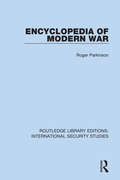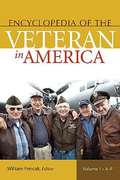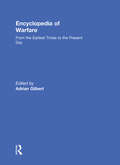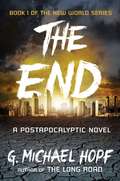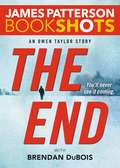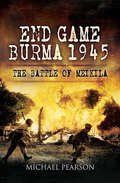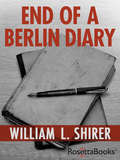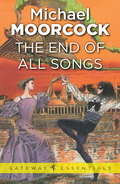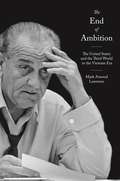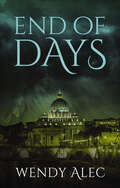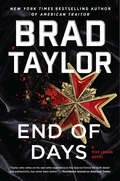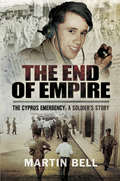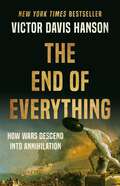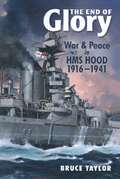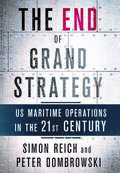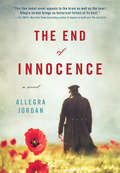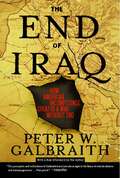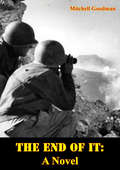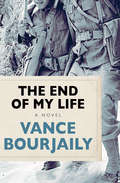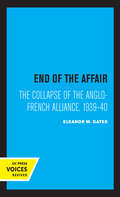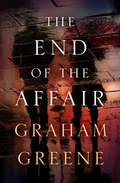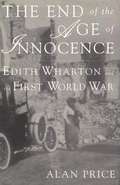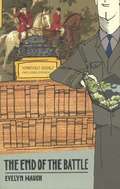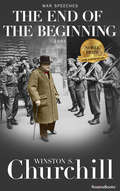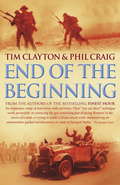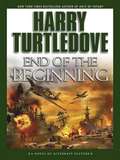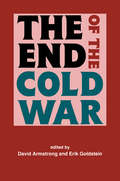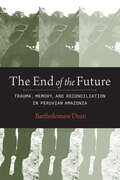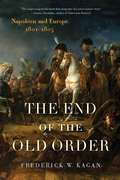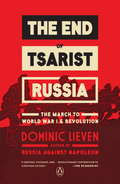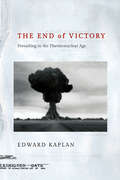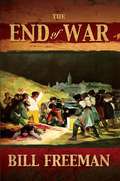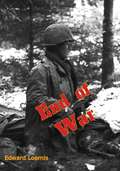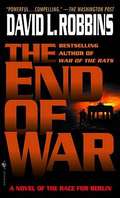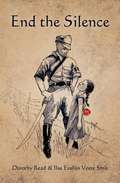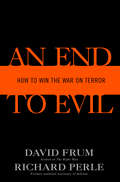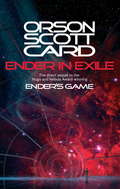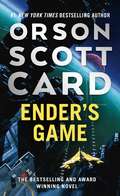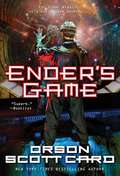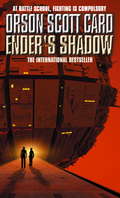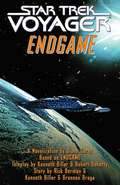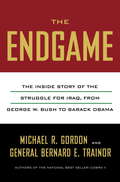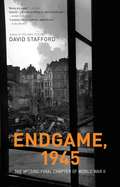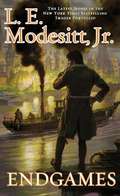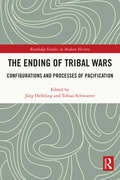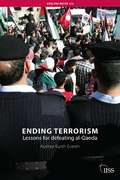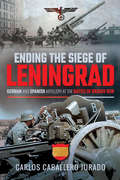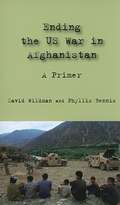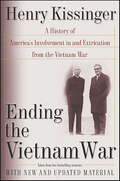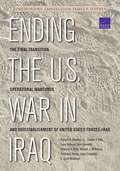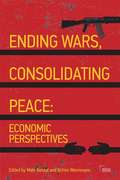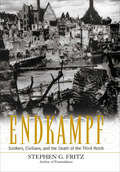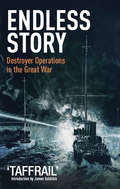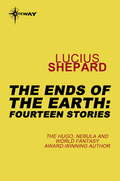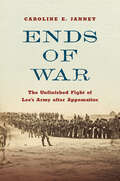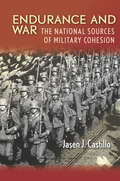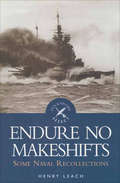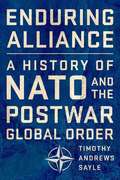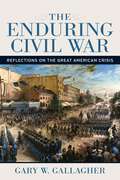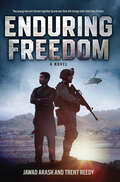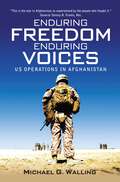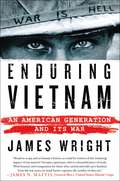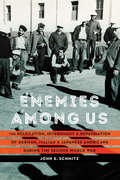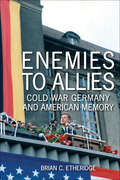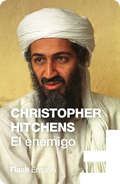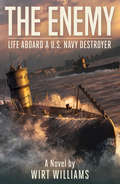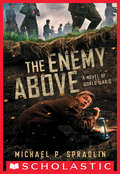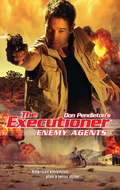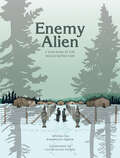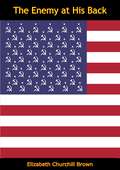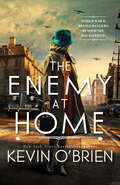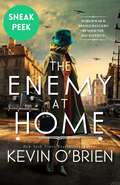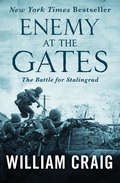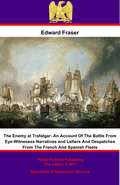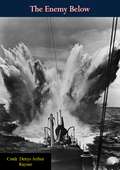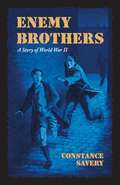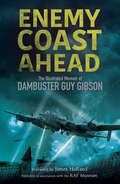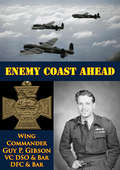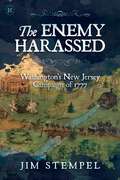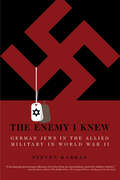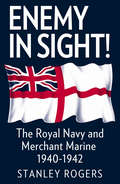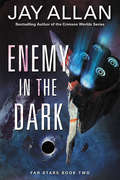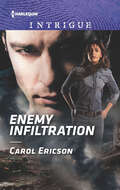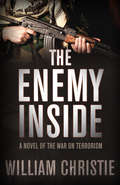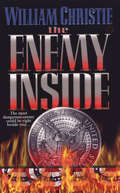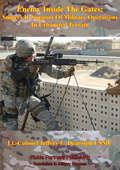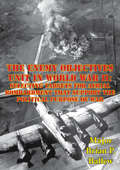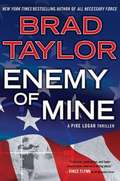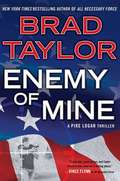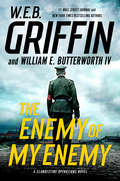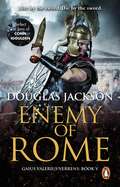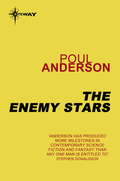Encyclopedia of Modern War (Routledge Library Editions: International Security Studies #5)
by Roger ParkinsonThis book, first published in 1977, presents a comprehensive survey of the upheavals experienced in warfare from 1793 to the end of the twentieth century, a period that saw many fundamental changes – from the Napoleonic wars to the advent of total war, guerrilla and nuclear warfare. It discusses in detail the main aspects of warfare – battles, weapons, and people. It concentrates equally on all three, not emphasising one aspect at the expense of the others, and allowing cross-references between them so as to fit them into the general pattern of development. Also included are other factors essential to an understanding of modern warfare, such as technological items, and conceptual entries such as basic strategy and tactics, and various military theories and principles.
Encyclopedia of the Veteran in America
by William PencakA comprehensive encyclopedia that describes the experiences of American veterans from the Revolutionary War to the present.
Encyclopedia of Warfare: From the Earliest Times to the Present Day
by Adrian GilbertThe Encyclopedia of Warfare is a chronological account of the development of warfare since the beginnings of recorded history. The book is organized in 10 chapters, each of which looks at a particular era in warfare from the ancient world to the present. Each chapter includes color maps of key campaigns, as well as commentary on battles, personalities, troops, and equipment. Sidebars throughout the main narrative focus on noteworthy aspects of the history of conflict. Through its chronological organization and ample use of maps, the Encyclopedia also clearly conveys the link between war and world geographical history. A thorough yet concise exploration of combat throughout human history, this fascinating and informative reference work is an outstanding addition to any library collection.
The End: A Postapocalyptic Novel (New World Series #1)
by G. Michael HopfWhat would you do to survive?<P><P> Young Gordon Van Zandt valued duty and loyalty to country above all, so after 9/11, he dropped out of college and joined the Marine Corps. This idealism vanished one fateful day in a war-torn city in Iraq. Ten years later, he is still struggling with the ghosts of his past when a new reality is thrust upon him and his family: North America, Europe and the Far East have all suffered a devastating Super-EMP attack, which causes catastrophic damage to the nation's power grid and essential infrastructures. Everything from cell phones to cars to computers cease to function, putting society at a standstill.<P> With civilization in chaos, Gordon must fight for the limited and fast dwindling resources. He knows survival requires action and cooperation with his neighbors, but as the days wear on, so does all sense of civility within his community--and so he must make some of the most difficult decisions of his life in order to ensure his family's safety. <P> For readers of Going Home by A. American, Lights Out by David Crawford, Lucifer's Hammer by Jerry Pournelle and One Second After by William Forstchen.
The End: An Owen Taylor Story (BookShots)
by James Patterson Brendan DuboisIf the mission fails, it's World War III. Any questions? Owen Taylor is about to be betrayed on his final covert mission. It will take everything he has to make it home alive, and to save the woman he loves. BookShotsLIGHTNING-FAST STORIES BY JAMES PATTERSON Novels you can devour in a few hours Impossible to stop reading All original content from James Patterson
End Game Burma, 1945: Slim’s Masterstroke at Meikila
by Michael PearsonWhen the Burma campaign is discussed, the turning point battles of Imphal and Kohima are most often thought of. However General Bill Slims bold but risky plan to outflank the Japanese on the Irrawaddy at Mandalay deserves far more credit.With the Japanese withdrawing, Slims 14 Army (with two Corps XXXIII and IV) risked a punishing crossing of the mighty Irrawaddy at Mandalay opposed by the main Japanese army. To avoid this is was decided to split 14 Army and send IV Corps on an arduous 300 mile march to seize the town of Meiktila, 85 miles south, a vital rail and road hub and the main Japanese administrative base.Complete secrecy was essential as if the Japanese realized they faced only one Corps rather than two, they might have counter attacked successfully. In this detailed analysis of this crucial maneuver the author describes the plan, the risks, the actions, the seemingly insuperable logistic problems, and the efforts to retain US air support (for which Mountbatten was largely responsible).
End of a Berlin Diary
by William L. Shirer"When I came home from Berlin at Christmas time in 1940, I found most of my fellow countrymen unaware of what Hitler was really up to and somewhat confused as to how he had accomplished his evil designs. Some Americans didn't much care. Since it had been my lot to witness Europe's agony at first hand, I collected some of my notes in a book for the edification of such citizens as cared to read it. This book of notes is, in a way, a sequel to Berlin Diary. It is the end of my own small contribution to the Berlin story. There was a great deal, of course, that a reporter had not been able to learn in the frenzied Nazi capital beyond the Elbe. The sinister plots, the fateful decisions, that had plunged the world into such awful horror and misery had been made in secret. And what had really gone on in Germany after I left? Had defeat and collapse solved the German problem -- at least for the rest of our lifetime ? After the war's end I went back to Berlin to try to find out. I prowled the obscene ruins of the once proud capital and talked with the remnants of the Herrenvolk. At Nuremberg, amidst the debris of the lovely medieval town, I saw the surviving leaders of the Nazi gangster world, who had wielded such monstrous power so arrogantly when last I beheld them, finally brought to justice. Most important of all, I had access to a good part of the fourteen hundred tons of secret German documents that the Allies had captured intact. You will find the essential portions of many of them in this book. I have been content to let the German authors tell in their own inimitable words the dark and almost unbelievable tale of their savagery and deceit. Had these secret archives of the German government been destroyed, as the Nazis intended them to be, much of the truth about our weird period in history would have been buried forever. Now it is here for those who care to learn it. I have also tried to include in this book the thread of another story -- the story of the beginning of the Peace. Reader, you and I have already forgotten the fleeting moment of glory and man's magnificent sense of dedication the day peace descended on this wretched earth. I know that erring mortals cannot remain on the heights for long. But these notes, scribbled down at the time, may help to remind you that many on our side achieved those heights after the war's bloody struggles had brought out their inhuman courage, their bravery, and their wonderful fortitude."
End of a Berlin Diary
by William L. Shirer&“A vivid and unforgettable word picture of the destruction of Nazi Germany&” (The New York Times). A radio broadcaster and journalist for Edward R. Murrow at CBS, William L. Shirer was new to the world of broadcast journalism when he began keeping a diary while on assignment in Europe during the 1930s. It was in 1940, when he was still virtually unknown, that Shirer wondered whether his eyewitness account of the collapse of the world around Nazi Germany could be of any interest or value as a book. Shirer&’s Berlin Diary, which is considered the first full record of what was happening in Germany during the rise of the Third Reich, appeared in 1941. The book was an instant success—and would not be the last of his expert observations on Europe. Shirer returned to the European front in 1944 to cover the end of the war. As the smoke cleared, Shirer—who watched the birth of a monster that threatened to engulf the world—now stood witness to the death of the Third Reich. End of a Berlin Diary chronicles this year-long study of Germany after Hitler. Through a combination of Shirer&’s lucid, honest reporting, along with passages on the Nuremberg trials, copies of captured Nazi documents, and an eyewitness account of Hitler&’s last days, Shirer provides insight into the unrest, the weariness, and the tentative steps world leaders took towards peace.
The End of All Songs (Gateway Essentials #405)
by Michael MoorcockJherek Carnelian and Mrs Amelia Underwood return to the End of Time from their brief exile in the Devonian Period to find the world under attack from the Lat and extinction a very real possibility. The perfect occasion, then, for love to bloom, the secret of Jherek's past to be revealed and the true nature of time to be unveiled...
The End of Ambition: The United States and the Third World in the Vietnam Era (America in the World #46)
by Mark Atwood LawrenceA groundbreaking new history of how the Vietnam War thwarted U.S. liberal ambitions in the developing world and at home in the 1960sAt the start of the 1960s, John F. Kennedy and other American liberals expressed boundless optimism about the ability of the United States to promote democracy and development in Asia, Africa, the Middle East, and Latin America. With U.S. power, resources, and expertise, almost anything seemed possible in the countries of the Cold War’s “Third World”—developing, postcolonial nations unaligned with the United States or Soviet Union. Yet by the end of the decade, this vision lay in ruins. What happened? In The End of Ambition, Mark Atwood Lawrence offers a groundbreaking new history of America’s most consequential decade. He reveals how the Vietnam War, combined with dizzying social and political changes in the United States, led to a collapse of American liberal ambition in the Third World—and how this transformation was connected to shrinking aspirations back home in America.By the middle and late 1960s, democracy had given way to dictatorship in many Third World countries, while poverty and inequality remained pervasive. As America’s costly war in Vietnam dragged on and as the Kennedy years gave way to the administrations of Lyndon B. Johnson and Richard M. Nixon, America became increasingly risk averse and embraced a new policy of promoting mere stability in the Third World. Paying special attention to the U.S. relationships with Brazil, India, Iran, Indonesia, and southern Africa, The End of Ambition tells the story of this momentous change and of how international and U.S. events intertwined.The result is an original new perspective on a war that continues to haunt U.S. foreign policy today.
End of Days (Chronicles of Brothers #3)
by Wendy AlecBrothers at war. Mankind deceived. Hell on Earth.A man face down in the dirt amid melting Arctic snow, a deep sense of unease but no memory of how he got there – Jason De Vere, once the head of a global media empire.Found and briefly taken to a safe house, Jason&’s soon on the run again – there&’s a 50-million-dollar bounty if he can be taken alive.Thrown together with his ex-wife and a crusading young journalist, Jason begins a desperate search for answers. It&’s a race against time, a fight for survival – and the stakes are higher than he could possibly have imagined.4 billion microchips – promising miraculous benefits – are being shipped to population centres around the world. And soon every human being on Earth will have to make a choice…CHRONICLES OF BROTHERS is the story of three brothers fighting for the future of humanity. From desert tombs, to the towers of Wall Street, to the ancient past, this super-epic tale reveals the hidden history of mankind and the origins of evil itself.
End of Days: A Pike Logan Novel (Pike Logan #16)
by Brad TaylorPike Logan must stop a deranged killer hell-bent on igniting an international conflagration in this explosive, action-packed thriller from New York Times bestselling author and former special forces officer, Brad Taylor.When a paragliding trip over the picturesque mountains of Switzerland results in the brutal murder of the former head of Israeli intelligence, Mossad brings in terrorist hunters Aaron and Shoshana to investigate. But they'll need help to find out who was behind the attack and what they’re planning next. Luckily, Aaron and Shoshana know exactly who to call.Taskforce operators Pike Logan and Jennifer Cahill have been trapped in Charleston, South Carolina during COVID-19, so when Aaron and Shoshana show up on their doorstep with Israeli passports and a new mission, they jump at the chance to assist their friends. Some suspect that Keta’ib Hezbollah, an Iranian-funded militia group operating in Iraq, might be responsible for the “accidental” deaths of key members of the American and Israeli governments. But something isn’t adding up, and Pike, Jennifer, and the two Mossad operators are determined to find the real assassins before more people are cut down.As they stumble upon the trail of a serial killer loose on the streets of Rome connected to the deaths and follow evidence leading to the exalted Knights of Malta, they must wade deep into the contentious religious and political fractures of Israel and the greater Middle East. It’s a dangerous world where fanatics and legitimate organizations exist side by side, and it’s up to the Taskforce to determine who is really pulling the strings. What they find could have disastrous consequences not only for them, but for the entire world…
The End of Empire: Cyprus: A Soldier's Story
by Martin Bell OBEMartin Bell, the former BBC was reporter and Independent MP, served as a soldier in the Suffolk Regiment during the Cyprus emergency between 1957 and 1959. In a chocolate box in the attic many years later he found more than 100 letters that he had sent home to his family. He was not a journalist then, but the letters give a vivid impression of what it was like to be a conscript on active service during the EOKA rebellion against British rule. They describe road blocks and cordons and searches, murders and explosions and riots and a strategy of armed repression that ultimately failed. From this beginning he has written The End of Empire.His narrative is a powerful and personal account of the violent process of decolonization, of the character of the British Army at the time and the impact of National Service on young men who were not much more than kids in uniform. It also gives a graphic insight into the ultimate futility of the use of force in wars among people and it reveals the true story of the insurgency and the campaign to defeat it.By drawing on recently declassified documents, he shows that Cyprus in the late 1950s was run not by the governor but by a military junta. The army commanders were looking for the knockout blow that would deliver victory, but their misguided tactics served only to strengthen support for their enemy.So The End Of Empire is much more than a personal reminiscence. It is an absorbing account of the experience of army life from the perspective of a private soldier, and it is the inside story of how Britain tried to crush a violent rebellion sixty years ago.
The End of Everything: How Wars Descend into Annihilation
by Victor Davis HansonIn this &“gripping account of catastrophic defeat&” (Barry Strauss), a New York Times–bestselling historian charts how and why some societies chose to utterly destroy their foes, and warns that similar wars of obliteration are possible in our time &“In The End of Everything, Hanson tells compelling and harrowing stories of how civilizations perished. He helps us consider contemporary affairs in light of that history, think about the unthinkable, and recognize the urgency of trying to prevent our own demise.&” — H. R. McMaster, author of Battlegrounds War can settle disputes, topple tyrants, and bend the trajectory of civilization—sometimes to the breaking point. From Troy to Hiroshima, moments when war has ended in utter annihilation have reverberated through the centuries, signaling the end of political systems, cultures, and epochs. Though much has changed over the millennia, human nature remains the same. Modern societies are not immune from the horror of a war of extinction. In The End of Everything, military historian Victor Davis Hanson narrates a series of sieges and sackings that span the age of antiquity to the conquest of the New World to show how societies descend into barbarism and obliteration. In the stories of Thebes, Carthage, Constantinople, and Tenochtitlan, he depicts war&’s drama, violence, and folly. Highlighting the naivete that plagued the vanquished and the wrath that justified mass slaughter, Hanson delivers a sobering call to contemporary readers to heed the lessons of obliteration lest we blunder into catastrophe once again.
The End of Glory: War & Peace in HMS Hood 1916-1941
by Bruce TaylorThe career of the legendary British battlecruiser is vividly recounted from its commissioning to its tragic end in this naval history. The HMS Hood was the glory of the Royal Navy. In The End of Glory, historian Bruce Taylor combines in-depth research and thrilling narrative to tell its story. For twenty years Hood symbolized the Royal Navy during the twilight years of the British Empire. Yet in 1941, it was destroyed in seconds by the battleship Bismarck, a catastrophe that shattered the morale the British public. Through official documents as well as the personal accounts and reminiscences of more than 150 crewmen, this volume offers a vivid portrait of this naval icon. An insider&’s view of a warship in peace and war, The End of Glory not only paints an intimate picture of everyday life but deals with controversial issues such as the Invergordon mutiny, escapades ashore and afloat, the Christmas mutiny of 1940 and the terrible conditions onboard in war. This coverage, based on so many original sources, makes for a truly compelling story that neither historian, enthusiast nor general reader will find easy to put down.
The End of Grand Strategy: US Maritime Operations in the Twenty-First Century
by Simon Reich Peter DombrowskiIn The End of Grand Strategy, Simon Reich and Peter Dombrowski challenge the common view of grand strategy as unitary. They eschew prescription of any one specific approach, chosen from a spectrum that stretches from global primacy to restraint and isolationism, in favor of describing what America’s military actually does, day to day. They argue that a series of fundamental recent changes in the global system, the inevitable jostling of bureaucratic politics, and the practical limitations of field operations combine to ensure that each presidential administration inevitably resorts to a variety of strategies. Proponents of different American grand strategies have historically focused on the pivotal role of the Navy. In response, Reich and Dombrowski examine six major maritime operations, each of which reflects one major strategy. One size does not fit all, say the authors—the attempt to impose a single overarching blueprint is no longer feasible. Reich and Dombrowski declare that grand strategy, as we know it, is dead. The End of Grand Strategy is essential reading for policymakers, military strategists, and analysts and critics at advocacy groups and think tanks.
The End of Innocence
by Allegra JordanOn the eve of WWI, two students fall in love in Harvard's hallowed halls and must face a world at war from opposing sides Helen Windship Brooks is struggling to find herself at the world-renowned Harvard-Radcliffe University when brooding German poet Wils bursts into her life. As they fall deeply in love on the brink of WWI, anti-German sentiments mount and Wils' future at Harvard-and in America-is in increasing danger. When Wils is called to fight for the Kaiser, Helen must decide if she is ready to fight her own battle for what she loves most. From Harvard's hallowed halls to Belgium's war-ravaged battlefields, The End of Innocence is a powerful new vision of finding love and hope in a violent, broken world.
The End of Iraq: How American Incompetence Created a War without End
by Peter W. GalbraithThe End of Iraq, definitive, tough-minded, clear-eyed, describes America's failed strategy toward that country and what must be done now. The United States invaded Iraq with grand ambitions to bring it democracy and thereby transform the Middle East. Instead, Iraq has disintegrated into three constituent components: a pro-western Kurdistan in the north, an Iran-dominated Shiite entity in the south, and a chaotic Sunni Arab region in the center. The country is plagued by insurgency and is in the opening phases of a potentially catastrophic civil war. George W. Bush broke up Iraq when he ordered its invasion in 2003. The United States not only removed Saddam Hussein, it also smashed and later dissolved the institutions by which Iraq's Sunni Arab minority ruled the country: its army, its security services, and the Baath Party. With these institutions gone and irreplaceable, the basis of an Iraqi state has disappeared. The End of Iraq describes the administration's strategic miscalculations behind the war as well as the blunders of the American occupation. There was the failure to understand the intensity of the ethnic and religious divisions in Iraq. This was followed by incoherent and inconsistent strategies for governing, the failure to spend money for reconstruction, the misguided effort to create a national army and police, and then the turning over of the country's management to Republican political loyalists rather than qualified professionals. As a matter of morality, Galbraith writes, the Kurds of Iraq are no less entitled to independence than are Lithuanians, Croatians, or Palestinians. And if the country's majority Shiites want to run their own affairs, or even have their own state, on what democratic principle should they be denied? If the price of a unified Iraq is another dictatorship, Galbraith writes in The End of Iraq, it is too high a price to pay. The United States must focus now, not on preserving or forging a unified Iraq, but on avoiding a spreading and increasingly dangerous and deadly civil war. It must accept the reality of Iraq's breakup and work with Iraq's Shiites, Kurds, and Sunni Arabs to strengthen the already semi-independent regions. If they are properly constituted, these regions can provide security, though not all will be democratic. There is no easy exit from Iraq for America. We have to relinquish our present strategy -- trying to build national institutions when there is in fact no nation. That effort is doomed, Galbraith argues, and it will only leave the United States with an open-ended commitment in circumstances of uncontrollable turmoil. Peter Galbraith has been in Iraq many times over the last twenty-one years during historic turning points for the country: the Iran-Iraq War, the Kurdish genocide, the 1991 uprising, the immediate aftermath of the 2003 war, and the writing of Iraq's constitutions. In The End of Iraq, he offers many firsthand observations of the men who are now Iraq's leaders. He draws on his nearly two decades of involvement in Iraq policy working for the U. S. government to appraise what has occurred and what will happen. The End of Iraq is the definitive account of this war and its ramifications.
The End Of It: A Novel (classic Reprint)
by Mitchell Goodman2nd Lieut. Mitchell Goodman's experiences form the basis for this vivid 1961 anti-war novel. The story focuses on an American artillery lieutenant, assimilated into the massive Allied invasion force, who is forced to re-examine his life and his beliefs by his experiences in beautiful but war-torn Italy.
The End of My Life: A Novel
by Vance BourjailyVance Bourjaily's classic novel of World War II dramatizes an entire generation's loss of innocence When Thomas "Skinner" Galt leaves Greenwich Village to volunteer as an ambulance driver with the British Army, he anticipates the adventure of a lifetime. What he fails to understand is that no matter where he comes from or how many books he has read, once he dons a military uniform, his life will cease to be his own. Stationed first in the Middle East and then in Italy, Skinner and his fellow American volunteers, Rod, Freak, and Benny, endure boredom, fear, and the exquisite frustration of following orders. They seek solace in their friendship with one another and in the debauched diversions available to men during wartime. But as the days and nights drag on, Skinner begins to drift away from his comrades--and from himself. Too late, he discovers that the path he has chosen leads only to tragedy. Inspired by Vance Bourjaily's experiences as an ambulance driver in the American Field Service and commissioned by legendary editor Maxwell Perkins, The End of My Life marked the arrival of a writer heralded by the New York Times as "a Dostoevsky of the generation that came of age in World War II." Elegant, spare, and fiercely honest, this is a timeless portrait of the devastating effects of war on the human spirit.
End of the Affair: The Collapse of the Anglo-French Alliance, 1939 - 40
by Eleanor M. GatesThis title is part of UC Press's Voices Revived program, which commemorates University of California Press’s mission to seek out and cultivate the brightest minds and give them voice, reach, and impact. Drawing on a backlist dating to 1893, Voices Revived makes high-quality, peer-reviewed scholarship accessible once again using print-on-demand technology. This title was originally published in 1981.
The End of the Affair (Virago Modern Classics #Vol. 13)
by Graham GreeneGraham Greene’s masterful novel of love and betrayal in World War II London is “undeniably a major work of art” (The New Yorker). Maurice Bendrix, a writer in Clapham during the Blitz, develops an acquaintance with Sarah Miles, the bored, beautiful wife of a dull civil servant named Henry. Maurice claims it’s to divine a character for his novel-in-progress. That’s the first deception. What he really wants is Sarah, and what Sarah needs is a man with passion. So begins a series of reckless trysts doomed by Maurice’s increasing romantic demands and Sarah’s tortured sense of guilt. Then, after Maurice miraculously survives a bombing, Sarah ends the affair—quickly, absolutely, and without explanation. It’s only when Maurice crosses paths with Sarah’s husband that he discovers the fallout of their duplicity—and it’s more unexpected than Maurice, Henry, or Sarah herself could have imagined. Adapted for film in both 1956 and 1999, Greene’s novel of all that inspires love—and all that poisons it—is “singularly moving and beautiful” (Evelyn Waugh).
The End of the Age of Innocence: Edith Wharton and the First World War
by Alan PriceThis book provides an overview of Wharton's life during World War II and how the war affected her writing and world-view. This book includes extensive new information on Wharton - based upon her unpublished letters, archival materials, and the extensive research by the author.
The End of the Age of Innocence: Edith Wharton and the End of the First World War
by Alan PriceEvaluation of her work.
The End of the Battle (Sword of Honour Trilogy #3)
by Evelyn WaughGuy Crouchback is given one final assignment in Yugoslavia, at the end of WWII. Concluding volume of the Sword of Honour trilogy.
The End of the Beginning: 1943 (Winston S. Churchill War Speeches)
by Winston S. ChurchillThis collection of WWII speeches by the Nobel Prize-winning Prime Minister reflect his determination in the face of a fearsome enemy. 1942 was an important turning point in World War II. Britain and its allies had faced considerable challenges thus far. Beset by bombings and devastated by personal loss and the restrictions of war, the British public was losing patience with the war effort—and their prime minister. This collection of Winston Churchill&’s wartime speeches from 1942 provides an enlightening commentary on this volatile time in history from the point of view of one of its most prominent leaders. Churchill faced an uphill battle in his military efforts as well as in gathering political and public support for the struggle to come. But the tides had turned when the United States joined the war at the end of 1941. Churchill has been quoted as saying he felt certain of the Allied victory with the US on his side—and his speeches reflect this renewed sense of hope and conviction.
End of the Beginning
by Phil Craig Tim Clayton1942 - British troops are stranded in the desert, struggling to hold back Rommel's Afrika Corps. Hitler's armies have reached Moscow, and there are murmurs of discontent at home as new doubts emerge about Churchill's leadership. Elsewhere in Europe there is chilling evidence of the mounting persecution of the Jews, stretching from Poland to the Channel Islands. For many, it seems there is little hope. As in their acclaimed bestseller FINEST HOUR, the authors use the personal testimony of ordinary people - In END OF THE BEGINNING we meet again some of the people first encountered in FINEST HOUR, and get to know many more. Troops fighting for Montgomery in the desert, RAF pilots bombing German towns, a young Jewish woman deported to Auschwitz from Guernsey, the reality of the Home Front - these stories and many more paint a vivid picture of human endeavour in time of war. And, sixty years on from the Battle of Alamein, END OF THE BEGINNING tells the controversial truth about one of the most famous battles in history - the importance of its lesser-known predecessor and the months of bitter in-fighting between the Allied generals. With precision and compassion, Phil Craig and Tim Clayton again debunk the myths and explore the realities of a crucial year in the history of Britain.
End of the Beginning (Pacific War Series #2)
by Harry TurtledoveSix weeks ago, Imperial Japanese military forces conquered and occupied the Hawaiian Islands. A puppet king sits on Hawaii's throne, his strings controlled by the general of the invasion force. American POWs, malnourished and weak, are enslaved as hard laborers until death takes them. Civilians fare little better, struggling to survive on dwindling resources. And families of Japanese origin find their loyalties divided. Meanwhile, across the United States, from Pensacola, Florida, to San Diego, California, the military is marshaling its forces. Steel factories and fuel refineries are operating around the clock. New recruits are enlisting, undergoing rigorous training exercises. All for the opportunity to strike back and drive the enemy from American soil...
The End of the Cold War
by David Armstrong Erik GoldsteinGiving an overview of the origins and history of the Cold War, this work considers whether the Cold War is truly over, and what the effects have been on Europe, and the former Soviet Union, as well as US foreign policy.
The End of the Future: Trauma, Memory, and Reconciliation in Peruvian Amazonia
by Bartholomew DeanIn The End of the Future, author Bartholomew Dean broadens the theoretical framework for understanding memory's role in reconciliation following a violent conflict. This book explores the complicated and confusing linkages between memory and trauma for individuals caught up in civil war and post-conflict reconciliation in the Peruvian Amazon's Huallaga Valley—an epicenter for leftist rebels and a booming shadow economy based on the extraction and circulation of cocaine. The End of the Future tells the story of violent attempts by the Túpac Amaru Revolutionary Movement (Movimiento Revolucionario Túpac Amaru, MRTA) to overthrow the state in the late 1980s and early 1990s from the perspective of the poorest residents of the lower Huallaga's Caynarachi Basin. To give context to the causes and consequences of the MRTA's presence in the lower and central Huallaga, this book relies on the written works and testimony of Sístero García Torres, an MRTA rebel commander; the government's Truth and Reconciliation Commission; MRTA propaganda; media accounts; and critical historical texts. Besides exposing Huallaga Valley human rights abuses, the book's contribution to political anthropology is consequential for its insistence that reconciliation is by no means equivalent to local, Indigenous notions of "justice" or customary forms of dispute resolution. Without deliberately addressing the diverse socio-cultural contours defining overlapping epistemologies of justice, freedom, and communal well-being, enduring reconciliation will likely remain elusive.
End of the Game (Destroyer #60)
by Richard Sapir Warren MurphyWhen a California Video game programmer gets board he begins manipulating people's lives for fun. When his boardom, leads him into an attempt at neuclear war, Remo is sent in to provide entertainmet.
The End of the Old Order: Napoleon and Europe, 1801-1805
by Frederick KaganPerhaps no person in history has dominated his or her own era as much as Napoleon. Despite his small physical stature, the shadow of Napoleon is cast like a colossus, compelling all who would look at that epoch to chart their course by reference to him. For this reason, most historical accounts of the Napoleonic era-and there are many-tell the same Napoleon-dominated story over and over again, or focus narrowly on special aspects of it. Frederick Kagan, distinguished historian and military policy expert, has tapped hitherto unused archival materials from Austria, Prussia, France, and Russia, to present the history of these years from the balanced perspective of all of the major players of Europe. InThe End of the Old Orderreaders encounter the rulers, ministers, citizens, and subjects of Europe in all of their political and military activity-from the desk of the prime minister to the pen of the ambassador, from the map of the general to the rifle of the soldier. With clear and lively prose, Kagan guides the reader deftly through the intriguing and complex web of international politics and war. The End of the Old Orderis the first volume in a new and comprehensive four-volume study of Napoleon and Europe. Each volume in the series will surprise readers with a dramatically different tapestry of early nineteenth-century personalities and events and will revise fundamentally our ages-old understanding of the wars that created modern Europe.
The End of Tsarist Russia: The March to World War I and Revolution
by Dominic LievenAn Economist Best Book of the YearA Financial Times Best Book of the YearWinner of the the Pushkin House Russian Book PrizeFinalist for the Lionel Gelber PrizeAn Amazon Best Book of the Month (History)One of the world's leading scholars offers a fresh interpretation of the linked origins of World War I and the Russian Revolution"Lieven has a double gift: first, for harvesting details to convey the essence of an era and, second, for finding new, startling, and clarifying elements in familiar stories. This is history with a heartbeat, and it could not be more engrossing."--Foreign AffairsWorld War I and the Russian Revolution together shaped the twentieth century in profound ways. In The End of Tsarist Russia, acclaimed scholar Dominic Lieven connects for the first time the two events, providing both a history of the First World War's origins from a Russian perspective and an international history of why the revolution happened. Based on exhaustive work in seven Russian archives as well as many non-Russian sources, Dominic Lieven's work is about far more than just Russia. By placing the crisis of empire at its core, Lieven links World War I to the sweep of twentieth-century global history. He shows how contemporary hot issues such as the struggle for Ukraine were already crucial elements in the run-up to 1914. By incorporating into his book new approaches and comparisons, Lieven tells the story of war and revolution in a way that is truly original and thought-provoking.From the Hardcover edition.
The End of Victory: Prevailing in the Thermonuclear Age
by Edward KaplanThe End of Victory recounts the costs of failure in nuclear war through the work of the most secret deliberative body of the National Security Council, the Net Evaluation Subcommittee (NESC). From 1953 onward, US leaders wanted to know as precisely as possible what would happen if they failed in a nuclear war—how many Americans would die and how much of the country would remain. The NESC told Presidents Dwight Eisenhower and John F. Kennedy what would be the result of the worst failure of American strategy—a maximum-effort surprise Soviet nuclear assault on the United States. Edward Kaplan details how NESC studies provided key information for presidential decisions on the objectives of a war with the USSR and on the size and shape of the US military. The subcommittee delivered its annual reports in a decade marked by crises in Berlin, Quemoy and Matsu, Laos, and Cuba, among others. During these critical moments and day-to-day containment of the USSR, the NESC's reports offered the best estimates of the butcher's bill of conflict and of how to reduce the cost in American lives.Taken with the intelligence community's assessment of the probability of a surprise attack, the NESC's work framed the risks of US strategy in the chilliest years of the Cold War. The End of Victory reveals how all policy decisions run risks—and ones involving military force run grave ones—though they can rarely be known with precision.
The End of War
by Bill FreemanThe End of War is a study of war and the possibility of peace. In the past empires used war and the threat of war as a way to dominate and exploit others, but in the modern world that is no longer possible. A new multi-lateral world is emerging where all nations will be required to ensure peace. Wars are diminishing but it will require a major effort if we are to go the final step to bring an end to the violence.
End of War
by Edward LoomisHe came from Ohio. Young, unsure of himself, innocent. He came to Europe as an infantryman battling his way into the heart of Germany.There he stopped being unsure of himself. He stopped when he first went into battle and heard the singing of bullets close overhead, heard the crump of the four-inch mortars and saw the Tiger tanks rumbling towards him.He grew to maturity when he killed his first German and he stopped being innocent when he bought his first woman...for a bar of chocolate.When the war ended and the fighting died away, how was he to regain his lost innocence? How was he to lose the habits of a killer?There was no one to help him except Chrystel, the refugee with the body of a girl and the heart of a woman. No one but Chrystel...and himself.
The End of War: A Novel of the Race for Berlin
by David L. RobbinsIn the final months of the Second World War, one strategic question above all occupies the Allies: which liberating army will be the first to march into Berlin? On the western front, Montgomery lobbies for the honour, while Eisenhower becomes more and more determined to thwart him and put an American general -- Bradley or Patton -- in charge of the final thrust; in the east, Stalin's armies advance steadily and ruthlessly towards the apotheosis of their vengeance.
End the Silence
by Dorothy Read Ilse Evelijn Veere SmitEnd the Silence tells the story of Ilse, an Indo-European born into an idyllic childhood in the colonial society of the Dutch East Indies. Ilse's privileged life was forever changed when the Japanese invaded her homeland during World War II. She recounts her years of internment in a Japanese concentration camp on Java. Then, at the war's end she walked out of Camp Halmaheira only to walk into the bloody Indonesian revolution where she was targeted for execution by native freedom fighters. Finally, she tells of the pain she suffered trying to cope with her memories in a family that refused to talk about it. As Ilse recalls the scenes in her remarkable journey, Dorothy Read paints them in the words of both the young Ilse who lived them and today's Ilse who reflects upon them.
An End to Evil
by David Frum Richard PerleAn End to Evil charts the agenda for what's next in the war on terrorism, as articulated by David Frum, former presidential speechwriter and bestselling author of The Right Man, and Richard Perle, former assistant secretary of defense and one of the most influential foreign-policy leaders in Washington. This world is an unsafe place for Americans--and the U.S. government remains unready to defend its people. In An End to Evil, David Frum and Richard Perle sound the alert about the dangers around us: the continuing threat from terrorism, the crisis with North Korea, the aggressive ambitions of China. Frum and Perle provide a detailed, candid account of America's vulnerabilities: a military whose leaders resist change, intelligence agencies mired in bureaucracy, diplomats who put friendly relations with their foreign colleagues ahead of the nation's interests. Perle and Frum lay out a bold program to defend America--and to win the war on terror. Among the topics this book addresses: * why the United States risks its security if it submits to the authority of the United Nations * why France and Saudi Arabia have to be treated as adversaries, not allies, in the war on terror * why the United States must take decisive action against Iran--now* what to do in North Korea if negotiations fail* why everything you read in the newspapers about the Israeli-Arab dispute is wrong * how our government must be changed if we are to fight the war on terror to victory--not just stalemate * where the next great terror threat is coming from--and what we can do to protect ourselves An End to Evil will define the conservative point of view on foreign policy for a new generation--and shape the agenda for the 2004 presidential-election year and beyond. With a keen insiders' perspective on how our leaders are confronting--or not confronting--the war on terrorism, David Frum and Richard Perle make a convincing argument for why the toughest line is the safest line.From the Hardcover edition.
Ender In Exile: Book 5 of the Ender Saga (Ender Saga #5)
by Orson Scott Card'The novels of Orson Scott Card's Ender series are an intriguing combination of action, military and political strategy, elaborate war games and psychology.' - USA TODAY'Hugo and Nebula-award winner Orson Scott Card demonstrates again that he belongs in the company of such older masters of science fiction as Isaac Asimov, Frank Herbert and Ursula K. Le Guin.' - Magill Book ReviewsAt first, Ender believed that they would bring him back to Earth as soon as things quieted down. But things were quiet now, had been quiet for a year, and it was plain to him now that they would not bring him back at all, that he was much more useful as a name and a story than he would ever be as an inconveniently flesh-and-blood person.At the close of ENDER'S GAME, Andrew Wiggin - called Ender by everyone - knows that he cannot live on Earth. He has become far more than just a boy who won a game: he is the Saviour of Earth, a hero, a military genius whose allegiance is sought by every nation of the newly shattered Earth Hegemony.He is offered the choice of living under the Hegemon's control, a pawn in his brother Peter's political games. Or he can join the colony ships and go out to settle one of the new worlds won in the war. The story of those years on the colony worlds has never been told . . . until now.The direct sequel to the Hugo and Nebula Award-winning bestseller, ENDER'S GAME.Books by Orson Scott Card:Alvin Maker novelsSeventh SonRed ProphetPrentice AlvinAlvin JourneymanHeartfireThe Crystal CityEnder Wiggin SagaEnder's GameSpeaker for the DeadXenocideChildren of the MindEnder in ExileHomecomingThe Memory of the EarthThe Call of the EarthThe Ships of the EarthEarthfallEarthbornFirst Formic War (with Aaron Johnston)Earth UnawareEarth AfireEarth Awakens
Ender's Game: Response Journal (The Ender Quintet #1)
by Orson Scott CardWinner of the Hugo and Nebula AwardsIn order to develop a secure defense against a hostile alien race's next attack, government agencies breed child geniuses and train them as soldiers. A brilliant young boy, Andrew "Ender" Wiggin lives with his kind but distant parents, his sadistic brother Peter, and the person he loves more than anyone else, his sister Valentine. Peter and Valentine were candidates for the soldier-training program but didn't make the cut—young Ender is the Wiggin drafted to the orbiting Battle School for rigorous military training.Ender's skills make him a leader in school and respected in the Battle Room, where children play at mock battles in zero gravity. Yet growing up in an artificial community of young soldiers Ender suffers greatly from isolation, rivalry from his peers, pressure from the adult teachers, and an unsettling fear of the alien invaders. His psychological battles include loneliness, fear that he is becoming like the cruel brother he remembers, and fanning the flames of devotion to his beloved sister. Is Ender the general Earth needs? But Ender is not the only result of the genetic experiments. The war with the Buggers has been raging for a hundred years, and the quest for the perfect general has been underway for almost as long. Ender's two older siblings are every bit as unusual as he is, but in very different ways. Between the three of them lie the abilities to remake a world. If, that is, the world survives.Ender's Game is the winner of the 1985 Nebula Award for Best Novel and the 1986 Hugo Award for Best Novel.At the Publisher's request, this title is being sold without Digital Rights Management Software (DRM) applied.
Ender's Game (Ender's Game #1)
by Orson Scott CardIn order to develop a secure defense against a hostile alien race's next attack, government agencies breed child geniuses and train them as soldiers. A brilliant young boy, Andrew "Ender" Wiggin lives with his kind but distant parents, his sadistic brother Peter, and the person he loves more than anyone else, his sister Valentine. Peter and Valentine were candidates for the soldier-training program but didn't make the cut — young Ender is the Wiggin drafted to the orbiting Battle School for rigorous military training.<P><P> Ender's skills make him a leader in school and respected in the Battle Room, where children play at mock battles in zero gravity. Yet growing up in an artificial community of young soldiers Ender suffers greatly from isolation, rivalry from his peers, pressure from the adult teachers, and an unsettling fear of the alien invaders. His psychological battles include loneliness, fear that he is becoming like the cruel brother he remembers, and fanning the flames of devotion to his beloved sister.<P> Is Ender the general Earth needs? But Ender is not the only result of the genetic experiments. The war with the Buggers has been raging for a hundred years, and the quest for the perfect general has been underway for almost as long. Ender's two older siblings are every bit as unusual as he is, but in very different ways. Between the three of them lie the abilities to remake a world. If, that is, the world survives.<P> Hugo and Nebula Awards Winner.
Ender's Shadow: Book 1 of The Shadow Saga (Shadow Saga #1)
by Orson Scott Card'The emotional punch is still as powerful as ever. Excellent.' - SFX'Haunting, compulsive, urgently readable...Story-telling genius.' - InterzoneOrson Scott Card is one of the world's bestselling SF authors, and the award-winning Ender saga is one of the best-loved series in the genre. ENDER'S SHADOW is the first volume in a new Ender series. Returning to the time of Ender's Game, ENDER'S SHADOW follows the incredible story of one of Ender Wiggin's fellow pupils at Battle School. Compelling, compulsive reading, ENDER'S SHADOW is certain to thrill all fans of the original series and attract many new readers.The first book in a new Ender series by bestselling author Orson Scott Card.Books by Orson Scott Card:Alvin Maker novelsSeventh SonRed ProphetPrentice AlvinAlvin JourneymanHeartfireThe Crystal CityEnder Wiggin SagaEnder's GameSpeaker for the DeadXenocideChildren of the MindEnder in ExileHomecomingThe Memory of the EarthThe Call of the EarthThe Ships of the EarthEarthfallEarthbornFirst Formic War (with Aaron Johnston)Earth UnawareEarth AfireEarth Awakens
Endgame (Star Trek: Voyager)
by Diane Carey Christie GoldenFor seven tumultuous years, the U.S.S. Voyager has explored the Delta Quadrant, encountering strange alien civilizations and bizarre space-time anomalies as it steadfastly made its way back toward the safety of Federation space. Captain Kathryn Janeway and her heroic crew have faced all manner of harrowing danger and hostile life-forms -- including the Kazons, the Borg, and the Q -- while never losing sight of their ultimate goal: home. Now, at last, Voyager's epic trek may be nearing its end... After so many perilous and astounding adventures, will Captain Janeway finally bring her wayward starship back to the Alpha Quadrant? And what will become of her diverse yet tightly knit crew? Will Chakotay, B'Elanna Torres, and the other former Maquis freedom fighters face long-delayed justice for their crimes against the Federation? And is there any place in Starfleet for the uniquely independent Borg known as Seven of Nine? As the ultimate destiny of Voyager is revealed, all that is certain is that nothing will ever be the same!
The Endgame
by Michael R. Gordon Bernard E. TrainorEagerly anticipated in the wake of their national best seller Cobra II ("The superb, must-read military history of the invasion of Iraq"--Thomas L. Friedman), The Endgame is Michael R. Gordon and General Bernard E. Trainor's most ambitious and news-breaking book to date. A peerless work of investigative journalism and historical recreation ranging from 2003 to 2012, it gives us the first comprehensive, inside account of arguably the most widely reported yet least understood war in American history--from the occupation of Iraq to the withdrawal of American troops. Prodigiously researched, The Endgame is not only based on an abundance of highly classified, still-secret government documents but is also brilliantly informed by access to key figures in the White House, the military, the State and Defense departments, the intelligence community, and, most strikingly, by extensive interviews with both Sunni and Shiite leaders, key Kurdish politicians, tribal sheikhs, former insurgents, Sadrists, and senior Iraqi military officers, whose insights about critical turning points and previously unknown decisions made during the war have heretofore been conspicuously missing from the media's coverage of it. The Endgame is riveting as a blow-by-blow chronicle of the fighting. It is also relentlessly revealing, as it deftly pieces together the puzzle of the prosecution of American, Iraqi, and Iranian objectives, and the diplomatic intrigue and political struggle within Iraq since the American invasion.
Endgame, 1945: The Missing Final Chapter of World War II
by David Stafford"War is too important to be left to the generals," Georges Clemenceau once famously remarked. Stafford (Centre for the Study of the Two World Wars, U. of Edinburgh, UK) adds, "the history of war is too important to be left to the military historians alone," especially as they tend to end their accounts with the immediate cessation of hostilities and neglect the importance of war's aftermath. His method of capturing some of the realities of the final days and immediate aftermath, through mid-summer 1945, of World War II, is to weave together the biographies of "a handful of individuals," including a German mother separated from her sons and imprisoned by the Nazis, a British commando witness to the aftermath of the horrors of the concentration camps, an American soldier in Italy, a war correspondent traveling with Gen. Patton's forces into Germany, a Canadian officer in Holland, a German-Jewish exile serving as a British secret agent in Austria, a New Zealand intelligence officer working in opposition to the communists in the disputed city of Trieste, an American paratrooper in Berlin involved in some the very first manifestations of the Cold War confrontation with the Soviets, and a woman involved with humanitarian work for concentration camp victims. Annotation ©2008 Book News, Inc., Portland, OR (booknews.com)
Endgames (The Imager Portfolio #12)
by L. E. Modesitt Jr.Endgames is the stunning final volume in L. E. Modesitt, Jr's, New York Times bestselling epic fantasy series the Imager Portfolio, and the third book in the story arc that began with Madness in Solidar through Treachery's Tools and Assassin's Price.Solidar is in chaos.Charyn, the young and untested ruler of Solidar, has survived assassination, and he struggles to gain control of a realm in the grip of social upheaval, war, and rioting. Solidar cannot be allowed to slide into social and political turmoil that will leave the High Holders with their ancient power and privilege, and the common people with nothing.But the stakes are even higher than he realizes. <P><P>The Imager Portfolio #1 Imager / #2 Imager’s Challenge / #3 Imager’s Intrigue / #4 Scholar / #5 Princeps / #6 Imager’s Battalion / #7 Antiagon Fire / #8 Rex Regis / #9 Madness in Solidar / #10 Treachery’s Tools / #11 Assassin’s Price / #12 Endgames <P><P> Other series by L. E. Modesitt, Jr. The Saga of RecluceThe Corean ChroniclesThe Spellsong CycleThe Ghost BooksThe Ecolitan Matter <P><P>At the Publisher's request, this title is being sold without Digital Rights Management Software (DRM) applied.
The Ending of Tribal Wars: Configurations and Processes of Pacification (Routledge Studies in Modern History #79)
by Jürg Helbling Tobias SchwoererAll over the world and throughout millennia, states have attempted to subjugate, control and dominate non-state populations and to end their wars. This book compares such processes of pacification leading to the end of tribal warfare in seven societies from all over the world between the 19th and 21st centuries. It shows that pacification cannot be understood solely as a unilateral imposition of state control but needs to be approached as the result of specific interactions between state actors and non-state local groups. Indigenous groups usually had options in deciding between accepting and resisting state control. State actors often had to make concessions or form alliances with indigenous groups in order to pursue their goals. Incentives given to local groups sometimes played a more important role in ending warfare than repression. In this way, indigenous groups, in interaction with state actors, strongly shaped the character of the process of pacification. This volume’s comparison finds that pacification is more successful and more durable where state actors mainly focus on selective incentives for local groups to renounce warfare, offer protection, and only as a last resort use moderate repression, combined with the quick establishment of effective institutions for peaceful conflict settlement.
Ending Terrorism: Lessons for defeating al-Qaeda (Adelphi series)
by Audrey Kurth CroninLike all other terrorist movements, al-Qaeda will end. While it has traits that exploit and reflect the current international context, it is not utterly without precedent: some aspects of al-Qaeda are unusual, but many are not. Terrorist groups end according to recognisable patterns that have persisted for centuries, and they reflect, among other factors, the counter-terrorist policies taken against them. It makes sense to formulate those policies with a specific image of an end in mind. Understanding how terrorism ends is the best way to avoid being manipulated by the tactic. There is vast historical experience with the decline and ending of terrorist campaigns, yet few policymakers are familiar with it. This paper first explains five typical strategies of terrorism and why Western thinkers fail to grasp them. It then describes historical patterns in ending terrorism to suggest how insights from that history can lay a foundation for more effective counter-strategies. Finally, it extracts policy prescriptions specifically relevant to ending the campaign of al-Qaeda and its associates, moving towards a post-al-Qaeda world.
Ending the Siege of Leningrad: German and Spanish Artillery at the Battle of Krasny Bor
by Carlos Caballero JuradoThis vivid combat history examines the role of German and Spanish artillery in the WW2 fight for control of Leningrad.When Nazi Germany invaded the Soviet Union in 1941, it quickly established a blockade around Leningrad that would become one of the longest and most destructive in history. In an attempt to break the blockade in 1943, the Red Army launched an offensive near the town of Krasny Bor. Previous works on the Battle of Krasny Bor have focused on the infantry involved, while little attention has been paid to the use of German and Spanish artillery in the conflict. In Ending the Siege of Leningrad, Spanish military historian Carlos Caballero Jurado corrects this oversight. Describing the action from an artilleryman’s point of view, Jurado puts the reader in the heart of the battle.
Ending the US War in Afghanistan: A Primer
by David Wildman Phyllis BennisThe Bush Administration answered the terror attacks of September 11, 2001 with what it called the "global war on terror," first with the assault on Afghanistan and then the invasion of Iraq. More and more Americans joined the opposition to the Iraq war, but for many, Afghanistan remained "the good war." But was the war on Afghanistan ever a "good war?" And will President Obama's planned escalation of US troop presence in Afghanistan work? In this easy-to-read volume of "frequently asked questions," analysts David Wildman and Phyllis Bennis examine a wide range of key issues regarding the US war in Afghanistan.
Ending the Vietnam War: A History of America's Involvement in and Extrication from the Vietnam War
by Henry KissingerNow, for the first time, Kissinger gives us in a single volume an in-depth, inside view of the Vietnam War, personally collected, annotated, revised, and updated from his bestselling memoirs and his book Diplomacy.Many other authors have written about what they thought happened—or thought should have happened—in Vietnam, but it was Henry Kissinger who was there at the epicenter, involved in every decision from the long, frustrating negotiations with the North Vietnamese delegation to America's eventual extrication from the war.Here, Kissinger writes with firm, precise knowledge, supported by meticulous documentation that includes his own memoranda to and replies from President Nixon. He tells about the tragedy of Cambodia, the collateral negotiations with the Soviet Union and the People's Republic of China, the disagreements within the Nixon and Ford administrations, the details of all negotiations in which he was involved, the domestic unrest and protest in the States, and the day-to-day military to diplomatic realities of the war as it reached the White House.As compelling and exciting as Barbara Tuchman's The Guns of August, Ending the Vietnam War also reveals insights about the bigger-than-life personalities—Johnson, Nixon, de Gaulle, Ho Chi Minh, Brezhnev—who were caught up in a war that forever changed international relations. This is history on a grand scale, and a book of overwhelming importance to the public record.
Ending The U.s. War In Iraq
by Richard R. Brennan Charles P. Ries Larry Hanauer Ben Connable Terrence K. KellyEnding the U. S. war in Iraq required redeploying 100,000 military and civilian personnel; handing off responsibility for 431 activities to the Iraqi government, U. S. embassy, USCENTCOM, or other U. S. government entities; and moving or transferring ownership of over a million pieces of property in accordance with U. S. and Iraqi laws, national policy, and DoD requirements. This book examines the planning and execution of this transition.
Ending Wars, Consolidating Peace: Economic Perspectives (Adelphi series)
by Mats Berdal Achim WennmannThe transition from war to peace is fraught with tension and the risk of a return to bloodshed. With so much at stake, it is crucial that the international community and local stakeholders make sense of the complex mosaic of challenges, to support a lasting, inclusive and prosperous peace. Recent missions, such as in Afghanistan, Somalia, or Sudan, have highlighted the fact that there can be no one-size-fits-all approach to steering countries away from violence and towards stability. This Adelphi offers a series of economic perspectives on conflict resolution, to show how the challenges of peacebuilding can be more effectively tackled. From the need to marry diplomatic peacemaking with development efforts, and activate the private sector in the service of peacebuilding aims, to the use of taxes and natural resource revenues as a financial base for sustainable peace, this book considers how economic factors can positively shape and drive peace processes. It takes an unflinching look at the complex ways in which power and order may be manifested in conflict zones, where unpalatable compromises with local warlords can often be the first step towards a more lasting settlement. A difficult balance must be struck by peacemakers and peacebuilders in assisting countries and communities in their transitions out of war, for the consequences of failure for countries and the wider world are too grave. In distilling expertise from a range of disciplines, this Adelphi seeks to inform a more economically integrated and responsive approach to helping countries leave behind their troubled pasts and take a fuller role in constructing their futures.
Endkampf: Soldiers, Civilians, and the Death of the Third Reich
by Stephen G. FritzAt the end of World War II, Gen. Dwight D. Eisenhower, fearing that retreating Germans would consolidate large numbers of troops in an Alpine stronghold and from there conduct a protracted guerilla war, turned U.S. forces toward the heart of Franconia, ordering them to cut off and destroy German units before they could reach the Alps. Opposing this advance was a conglomeration of German forces headed by SS-Gruppenführer Max Simon, a committed National Socialist who advocated merciless resistance. Under the direction of officers schooled in harsh combat in Russia, the Germans succeeded in bringing the American advance to a grinding halt. Caught in the middle were the people of Franconia. Historians have accorded little mention to this period of violence and terror, but it provides insight into the chaotic nature of life while the Nazi regime was crumbling. Neither German civilians nor foreign refugees acted simply as passive victims caught between two fronts. Throughout the region people pressured local authorities to end the senseless resistance and sought revenge for their tribulations in the "liberation" that followed. Stephen G. Fritz examines the predicament and outlook of American GI's, German soldiers and officials, and the civilian population caught in the arduous fighting during the waning days of World War II. Endkampf is a gripping portrait of the collapse of a society and how it affected those involved, whether they were soldiers or civilians, victors or vanquished, perpetrators or victims.
Endless Story: Destroyer Operations in the Great War
by James GoldrickAlthough it was first published in 1931, Endless Story remains the only comprehensive account of the services of the Navys small craft destroyers, torpedo boats and patrol vessels during the First World War, and moreover the only one written by an officer personally involved. Even if Dorling did not take part in all the actions he describes, he knew the men who did, and gleaned much of his information from personal contact. As a result the book has both authenticity and authority, but is composed with the all verve of the popular novelist that Taffrail was to become. It was a bestseller in its day, and now enjoys the status of a classic.
The Ends of the Earth: Fourteen Stories
by Lucius ShepardLucius Shepard's short fiction ranges far and wide over the field of SF and fantasy, and is crammed with show-stopper ideas and an intense originality. The Ends of the Earth is a testimonial to a genius of the genre, and a major American writer. Winner of the 1992 World Fantasy Award for Best Collection.Contents:The Ends of the Earth (1989)Delta Sly Honey (1987)Bound for Glory (1989)The Exercise of Faith (1987)Nomans Land (1988)Life of Buddha (1988)Shades (1987)Aymara (1986)A Wooden Tiger (1988)The Black Clay Boy (1987)Fire Zone Emerald (1985)On the Border (1987)The Scalehunter's Beautiful Daughter (1988)Surrender (1989)
Ends of War: The Unfinished Fight of Lee's Army after Appomattox
by Caroline E. JanneyThe Army of Northern Virginia's chaotic dispersal began even before Lee and Grant met at Appomattox Court House. As the Confederates had pushed west at a relentless pace for nearly a week, thousands of wounded and exhausted men fell out of the ranks. When word spread that Lee planned to surrender, most remaining troops stacked their arms and accepted paroles allowing them to return home, even as they lamented the loss of their country and cause. But others broke south and west, hoping to continue the fight. Fearing a guerrilla war, Grant extended the generous Appomattox terms to every rebel who would surrender himself. Provost marshals fanned out across Virginia and beyond, seeking nearly 18,000 of Lee's men who had yet to surrender. But the shock of Lincoln's assassination led Northern authorities to see threats of new rebellion in every rail depot and harbor where Confederates gathered for transport, even among those already paroled. While Federal troops struggled to keep order and sustain a fragile peace, their newly surrendered adversaries seethed with anger and confusion at the sight of Union troops occupying their towns and former slaves celebrating freedom. In this dramatic new history of the weeks and months after Appomattox, Caroline E. Janney reveals that Lee's surrender was less an ending than the start of an interregnum marked by military and political uncertainty, legal and logistical confusion, and continued outbursts of violence. Janney takes readers from the deliberations of government and military authorities to the ground-level experiences of common soldiers. Ultimately, what unfolds is the messy birth narrative of the Lost Cause, laying the groundwork for the defiant resilience of rebellion in the years that followed.
Endurance and War: The National Sources of Military Cohesion
by Jasen J. CastilloScholars and military practitioners alike have long sought to understand why some country's militaries fight hard when facing defeat while others collapse. In Endurance and War, Jasen Castillo presents a new unifying theory—cohesion theory—to explain why national militaries differ in their staying power. His argument builds on insights from the literatures on group solidarity in general and military effectiveness in particular, which argue that the stronger the ties binding together individuals in a group of any kind, the higher the degree of cohesion that a group will exhibit when taking collective action, including fighting in war. Specifically, he argues that two types of ties determine the cohesion, and therefore the resilience, of a nation's armed forces during war: the degree of control a regime holds over its citizens and the amount of autonomy the armed forces possess to focus on training for warfighting. Understanding why armed forces differ in their cohesion should help U.S. military planners better assess the military capabilities of potential adversaries, like Iran and North Korea. For scholars of international politics, cohesion theory can help provide insights into how countries create military power and how they win wars.
Endure (Need Pixies #4)
by Carrie JonesRescuing Nick should have made all of Zara's problems disappear. Bedford's greatest warrior is back, not to mention Zara's true soul mate. But it seems it isn't enough. Nick isn't enough. Bedford is being ravaged by evil pixies and they need much more than one great warrior; they need an army to stop the impended apocalypse. Zara isn't sure what her role is anymore. She's not just fighting for her friends, she's also a pixie queen. And to align her team of pixies with the humans she loves will be one of her greatest battles yet. Especially since she can't even reconcile her growing, heart-pounding feelings for her pixie king.... Unexpected turns, surprising revelations, and one utterly satisfying romantic finale make Endure a thrilling end to this acclaimed series.
Endure No Makeshifts: Some Naval Recollections
by Henry LeachSir Henry Leach spent forty-five years of active service in the Royal Navy, starting as a thirteen year old Cadet in 1937 and finishing as a fifty-nine year old Admiral of the Fleet in 1982. Son of a distinguished naval Captain, killed in action while commanding the Battleship Prince of Wales in 1941, he spent most of World War II at sea, mainly in the North Atlantic and the Far East.
Enduring Alliance: A History Of Nato And The Postwar Global Order
by Timothy Andrews SayleBorn from necessity, the North Atlantic Treaty Organization (NATO) has always seemed on the verge of collapse. Even now, some seventy years after its inception, some consider its foundation uncertain and its structure weak. At this moment of incipient strategic crisis, Timothy A. Sayle offers a sweeping history of the most critical alliance in the post-World War II era. In Enduring Alliance, Sayle recounts how the western European powers, along with the United States and Canada, developed a treaty to prevent encroachments by the Soviet Union and to serve as a first defense in any future military conflict. As the growing and unruly hodgepodge of countries, councils, commands, and committees inflated NATO during the Cold War, Sayle shows that the work of executive leaders, high-level diplomats, and institutional functionaries within NATO kept the alliance alive and strong in the face of changing administrations, various crises, and the flux of geopolitical maneuverings. Resilience and flexibility have been the true hallmarks of NATO. As Enduring Alliance deftly shows, the history of NATO is organized around the balance of power, preponderant military forces, and plans for nuclear war. But it is also the history riven by generational change, the introduction of new approaches to conceiving international affairs, and the difficulty of diplomacy for democracies. As NATO celebrates its seventieth anniversary, the alliance once again faces challenges to its very existence even as it maintains its place firmly at the center of western hemisphere and global affairs.
The Enduring Civil War: Reflections on the Great American Crisis
by Gary W. GallagherIn the seventy-three succinct essays gathered in The Enduring Civil War, celebrated historian Gary W. Gallagher highlights the complexity and richness of the war, from its origins to its memory, as topics for study, contemplation, and dispute. He places contemporary understanding of the Civil War, both academic and general, in conversation with testimony from those in the Union and the Confederacy who experienced and described it, investigating how mid-nineteenth-century perceptions align with, or deviate from, current ideas regarding the origins, conduct, and aftermath of the war. The tension between history and memory forms a theme throughout the essays, underscoring how later perceptions about the war often took precedence over historical reality in the minds of many Americans. The array of topics Gallagher addresses is striking. He examines notable books and authors, both Union and Confederate, military and civilian, famous and lesser known. He discusses historians who, though their names have receded with time, produced works that remain pertinent in terms of analysis or information. He comments on conventional interpretations of events and personalities, challenging, among other things, commonly held notions about Gettysburg and Vicksburg as decisive turning points, Ulysses S. Grant as a general who profligately wasted Union manpower, the Gettysburg Address as a watershed that turned the war from a fight for Union into one for Union and emancipation, and Robert E. Lee as an old-fashioned general ill-suited to waging a modern mid-nineteenth-century war. Gallagher interrogates recent scholarly trends on the evolving nature of Civil War studies, addressing crucial questions about chronology, history, memory, and the new revisionist literature. The format of this provocative and timely collection lends itself to sampling, and readers might start in any of the subject groupings and go where their interests take them.
Enduring Freedom
by Trent Reedy Jawad ArashSeptember 11, 2001 Two young men on opposite sides of the world One war that will change their lives forever Baheer, a studious Afghan teen, sees his family&’s life turned upside down when they lose their livelihood as war rocks the country. A world away, Joe, a young American army private, has to put aside his dreams of becoming a journalist when he&’s shipped out to Afghanistan. When Joe&’s unit arrives in Baheer&’s town, Baheer is wary of the Americans, but sees an opportunity: Not only can he practice his English with the soldiers, his family can make money delivering their supplies. At first, Joe doesn&’t trust Baheer, or any of the locals, but Baheer keeps showing up. As Joe and Baheer get to know each other, to see each other as individuals, they realize they have a lot more in common than they ever could have realized. But can they get past the deep differences in their lives and beliefs to become true friends and allies? Enduring Freedom is a moving and enlightening novel about how ignorance can tear us apart and how education and understanding can bring us back together."Through Baheer, readers ages 12 and older will gain some understanding of life under the Taliban; of the concussive shock of 9/11 as felt in Central Asia; of Afghans&’ varied responses to the American invasion; and most of all the transformative promise of schooling. Through Joe, an aspiring journalist, readers experience not only the throb of post-9/11patriotism but also the tedium, camaraderie and sudden terrors of soldiery in a war zone." --The Wall Street Journal
Enduring Freedom, Enduring Voices
by Michael G. WallingThe war in Afghanistan has become one of the most complex, challenging operations in the history of the US military. Using first-hand accounts of the men and women who fought in Operation Enduring Freedom, this book presents an intensely personal history of the war in Afghanistan, revealing the determination, heroism, sacrifice, and strength of spirit that came to form the fabric of the conflict.Enduring Freedom, Enduring Voices places the first-hand accounts of serving men and women into the context of the military operations. Drawing on gripping oral histories, from theater commanders, Special Forces troops, reconstruction teams, and everyday soldiers, Michael G. Walling analyzes operations as they were experienced by individuals, from those immediately following 9/11 through to those in 2014 as US troops prepared to withdraw. Written following a research trip to the region, in which the author spent considerable time embedded with the US forces, Walling's unique and intensely personal history offers a timely insight into the conflict as the majority of NATO forces are withdrawn - the final chapter in the story of US military operations in Afghanistan.He also charts the evolution of US military structure as it was forced to adapt to cope with the non-conventional, but nonetheless deadly threats of asymmetric warfare, as well as detailing covert ops, infrastructure rebuilding, and the training of Afghan forces.Resonating across gender, age, nationality, and ethnicity, this book is not just a document of US fortunes in a far-flung conflict. It is a tribute to the determination, heroism, sacrifice, and the strength of the human spirit. From the Hardcover edition.
Enduring Love: The Civil War Diaries of Benjamin Franklin Pierce (14th New Hampshire Vol. Inf.) and His Wife Harriett Jane Goodwin Pierce
by Sheila M. Cumberworth Daniel V. BilesWhile a Minnesota family was remodeling their home in the 1950s, they discovered a set of Civil diaries stuffed inside a wall. This book presents the edited diaries, along with material that places these personal accounts in context. The diaries included in this book were largely written from 1863 to 1865, while Frank Pierce was fighting in Virginia. At home in Bradford, New Hampshire, Harriette Pierce cared for her children and supported the family by sewing. The diaries reveal the love between Frank and Harriett and the stress of the long period of separation and uncertainty.
Enduring the Great War
by Alexander WatsonThis 2008 book is an innovative comparative history of how German and British soldiers endured the horror of the First World War. Unlike existing literature, which emphasises the strength of societies or military institutions, this study argues that at the heart of armies' robustness lay natural human resilience. Drawing widely on contemporary letters and diaries of British and German soldiers, psychiatric reports and official documentation, and interpreting these sources with modern psychological research, this unique account provides fresh insights into the soldiers' fears, motivations and coping mechanisms. It explains why the British outlasted their opponents by examining and comparing the motives for fighting, the effectiveness with which armies and societies supported men and the combatants' morale throughout the conflict on both sides. Finally it challenges the consensus on the war's end, arguing that not a 'covert strike' but rather an 'ordered surrender' led by junior officers brought about Germany's defeat in 1918.
Enduring Vietnam: An American Generation And Its War
by James WrightThe Vietnam War is largely recalled as a mistake, either in the decision to engage there or in the nature of the engagement. Or both. Veterans of the war remain largely anonymous figures, accomplices in the mistake. Critically recounting the steps that led to the war, this book does not excuse the mistakes, but it brings those who served out of the shadows.Enduring Vietnam recounts the experiences of the young Americans who fought in Vietnam and of families who grieved those who did not return. By 1969 nearly half of the junior enlisted men who died in Vietnam were draftees. And their median age was 21—among the non-draftees it was only 20. The book describes the “baby boomers” growing up in the 1950s, why they went into the military, what they thought of the war, and what it was like to serve in “Nam.” And to come home. With a rich narrative of the Battle for “Hamburger Hill,” and through substantial interviews with those who served, the book depicts the cruelty of this war, and its quiet acts of courage.James Wright's Enduring Vietnam provides an important dimension to the profile of an American generation—and a rich account of an American War.
Enemies among Us: The Relocation, Internment, and Repatriation of German, Italian, and Japanese Americans during the Second World War
by John E. SchmitzRecent decades have drawn more attention to the United States&’ treatment of Japanese Americans during World War II. Few people realize, however, the extent of the country&’s relocation, internment, and repatriation of German and Italian Americans, who were interned in greater numbers than Japanese Americans. The United States also assisted other countries, especially in Latin America, in expelling &“dangerous&” aliens, primarily Germans. In Enemies among Us John E. Schmitz examines the causes, conditions, and consequences of America&’s selective relocation and internment of its own citizens and enemy aliens, as well as the effects of internment on those who experienced it. Looking at German, Italian, and Japanese Americans, Schmitz analyzes the similarities in the U.S. government&’s procedures for those they perceived to be domestic and hemispheric threats, revealing the consistencies in the government&’s treatment of these groups, regardless of race. Reframing wartime relocation and internment through a broader chronological perspective and considering policies in the wider Western Hemisphere, Enemies among Us provides new conclusions as to why the United States relocated, interned, and repatriated both aliens and citizens considered enemies.
Enemies to Allies: Cold War Germany and American Memory (Studies In Conflict, Diplomacy, And Peace Ser.)
by Brian C. EtheridgeAt the close of World War II, the United States went from being allied with the Soviet Union against Germany to alignment with the Germans against the Soviet Union—almost overnight. While many Americans came to perceive the German people as democrats stan
El enemigo (Colección Endebate #Volumen)
by Christopher HitchensCon la muerte de Osama bin Laden el mundo pareció cerrar una época. Christopher Hitchens reflexiona acerca de la figura que atemorizó a Occidente durante diez años, su final y su sangriento y funesto legado. Todo cambió el 11 de septiembre de 2001 cuando 19 terroristas suicidas secuestraron cuatro aviones y sembraron el caos y la destrucción. El siglo XXI comenzaba cubierto de sangre y barro y el espectro de Al Qaeda y su líder, Osama bin Laden, ocuparon un espacio inusitado en el imaginario global. Desde la seguridad en los aeropuertos hasta las guerras de Afganistán e Iraq, la onda expansiva de esos atentados aún se hace notar. Diez años más tarde Estados Unidos acabó con su principal enemigo, pero ¿qué representaba Bin Laden? Más aún, ¿quién era y qué había conseguido? Esas son las preguntas que la incisiva pluma de Christopher Hitchens intenta responder.
The Enemy: Life Aboard a U.S. Navy Destroyer
by Wirt WilliamsThe Enemy, first published in 1951, is the wartime account of a fictional U.S. Navy destroyer, the USS Dee (based on the author’s experiences while serving aboard the USS Decatur in the North Atlantic). The ships’ mission is to locate and destroy German submarines while protecting an aircraft carrier. The book details life aboard the destroyer and the inevitable conflicts that arise between men at sea for long periods. The ship also encounters and engages enemy submarines, receiving slight damage. Following author Wirt Williams’ service aboard the USS Decatur, he was transferred to the Pacific theater where he captained a Landing Ship. After the war, Williams worked as a reporter, then became an English professor in California. He continued to write and published six novels, and was nominated for three Pulitzer Prizes, once for his reporting and twice for his novels. The Enemy was his first novel. Williams passed away in 1986 at the age of 64.
The Enemy Above: A Novel of World War II
by Michael P. SpradlinNazi gun fire can only mean one thing... The Germans are closing in. And twelve-year-old Anton knows his family can't outrun them. A web of underground caves seems like the perfect place to hide. But danger lurks above the surface. Ruthless Major Karl Von Duesen of the Gestapo has made it his mission to round up every Jew in the Ukrainian countryside. Anton knows if his community is discovered, they will be sent off to work camps...or worse. When a surprise invasion catches them off guard, Anton makes a radical decision. He won't run any longer. And he won't hide. He will stop being the hunted...and start doing some hunting of his own. Michael P. Spradlin's newest thriller is the ultimate game of cat and mouse set during one of the darkest moments in history.
Enemy Agents
by Don PendletonWhen California's Mojave Desert becomes the training ground for a homegrown militia group with a deadly scheme to "take back" America, Mack Bolan is sent in to unleash his own form of destruction. But first he'll have to infiltrate the unit and unravel their plot before it's too late. With less than forty-eight hours to go, the stakes have suddenly been raised and millions of Americans are about to be caught in the cross fire of a terrorist attack. As the militia sets its plan in motion, Bolan has only one opportunity to strike back and shut them down forever. Timing will be tight, but if these right-wing extremists want a war, then the Executioner is there to oblige.
Enemy Alien: A True Story of Life Behind Barbed Wire
by Kassandra LuciukThis graphic history tells the story of Canada’s first national internment operations through the eyes of John Boychuk, an internee held in Kapuskasing from 1914 to 1917. The story is based on Boychuk’s actual memoir, which is the only comprehensive internee testimony in existence. The novel follows Boychuk from his arrest in Toronto to Kapuskasing, where he spends just over three years. It details the everyday struggle of the internees in the camp, including forced labour and exploitation, abuse from guards, malnutrition, and homesickness. It also documents moments of internee agency and resistance, such as work slowdowns and stoppages, hunger strikes, escape attempts, and riots. Little is known about the lives of the incarcerated once the paper trail stops, but Enemy Alien subsequently traces Boychuk’s parole, his search for work, his attempts to organize a union, and his ultimate settlement in Winnipeg. Boychuk’s reflections emphasize the much broader context in which internment takes place. This was not an isolated incident, but rather part and parcel of Canadian nation building and the directives of Canada’s settler colonial project.
The Enemy at His Back
by Elizabeth Churchill BrownThis work discusses the communist schedule for taking over America and its potential loss of liberty. The author’s goal is to succeed in awakening the American people to the immediate mortal danger and have better knowledge on how to protect ourselves from communism.“Elizabeth Churchill Brown’s book is one of the clearest and most factual expositions of Communist influence on American foreign policies and actions that I have read. This book should be read in all American homes and schools and should be required reading by every American in Government Service.”—General Albert C. Wedemeyer
The Enemy at Home: A Thrilling Historical Suspense Novel of a WWII Era Serial Killer
by Kevin O'Brien&“Tantalizing…had me guessing and turning pages right up to the final, shocking reveal—which I never saw coming.&” —Charlie Donlea, bestselling author of Twenty Years Later Perfect for readers of The Nurse&’s Secret, this provocative and captivating new book from the New York Times bestselling author follows adiabolical murderer as he preys on women in WW2 era Seattle. Thoroughly researched, this gripping new historical thriller featuring a diverse, engaging cast of characters is at once vivid, richly detailed, and laced with taut suspense.&“Fast-paced, suspenseful, and intriguing... Super enjoyable.&” —Elizabeth George, #1 New York Times bestselling author&“A sweeping, addictive story of bravery and sacrifice…Authentic period detail creates a suspenseful, chilling atmosphere in this grand historical novel.&” —Susan Wiggs, #1 New York Times bestselling author 1943, Seattle. While raging war reshapes the landscape of Europe, its impact is felt thousands of miles away too. Before the war, Nora Kinney was one of countless housewives and mothers in her comfortable Capitol Hill neighborhood. Now, with her doctor husband stationed in North Africa, Nora feels compelled to do more than tend her victory garden or help with scrap metal drives . . . At the Boeing B-17 plant, Nora learns to wield a heavy riveting gun amid the deafening noise of the assembly line—a real-life counterpart to &“Rosie the Riveter&” in the recruitment posters. Yet while the country desperately needs their help, not everyone is happy about &“all these women&” taking over men&’s jobs. Nora worries that she is neglecting her children, especially her withdrawn teenage son. But amid this turmoil, a sinister tragedy occurs: One of Nora&’s coworkers is found strangled in her apartment, dressed in an apron, with a lipstick smile smeared on her face. It&’s the beginning of a terrifying pattern, as women war-plant workers like Nora are targeted throughout Seattle and murdered in the same ritualistic manner. And eclipsing Nora&’s fear for her safety is her secret, growing conviction that she and the killer are connected—and that the haven that was her home has become her own personal battlefield . . .&“Nobody writes suspense better than Kevin O&’Brien. Read The Enemy at Home, but do so with the lights on.&” —Robert Dugoni, New York Times bestselling author&“A compulsively unputdownable, keep-you-guessing-to-the-end, pages-flying whodunit. Packed with compelling, complicated characters in a fascinating and meticulously-researched time and place.&” —Laurie Frankel, New York Times bestselling author of This Is How It Always Is &“The curves in the plot kept me reading late into the night (while checking the locks on my doors!).&” —Erica Bauermeister, New York Times bestselling author of No Two Persons
The Enemy at Home: Sneak Peek
by Kevin O'BrienBe one of the first to read this sneak preview sample edition!&“A sweeping, addictive story of bravery and sacrifice…Authentic period detail creates a suspenseful, chilling atmosphere in this grand historical novel.&” —Susan Wiggs, #1 New York Times bestselling authors&“Fast-paced, suspenseful, and intriguing... Super enjoyable&” —Elizabeth George, #1 New York Times bestselling author&“Had me guessing and turning pages right up to the final, shocking reveal—which I never saw coming. A perfect summer read!&”—Charlie Donlea, USA Today bestselling authorA serial killer preys on women in WWII-era Seattle in the New York Times bestselling author&’s gripping new thriller—a blend of vivid, richly detailed historical fiction and taut suspense. 1943, Seattle. While raging war reshapes the landscape of Europe, its impact is felt thousands of miles away too. Before the war, Nora Kinney was one of countless housewives and mothers in her comfortable Capitol Hill neighborhood. Now, with her doctor husband stationed in North Africa, Nora feels compelled to do more than tend her victory garden or help with scrap metal drives . . . At the Boeing B-17 plant, Nora learns to wield a heavy riveting gun amid the deafening noise of the assembly line—a real-life counterpart to &“Rosie the Riveter&” in the recruitment posters. Yet while the country desperately needs their help, not everyone is happy about &“all these women&” taking over men&’s jobs. Nora worries that she is neglecting her children, especially her withdrawn teenage son. But amid this turmoil, a sinister tragedy occurs: One of Nora&’s coworkers is found strangled in her apartment, dressed in an apron, with a lipstick smile smeared on her face. It&’s the beginning of a terrifying pattern, as women war-plant workers like Nora are targeted throughout Seattle and murdered in the same ritualistic manner. And eclipsing Nora&’s fear for her safety is her secret, growing conviction that she and the killer are connected—and that the haven that was her home has become her own personal battlefield . . .&“A compulsively unputdownable, keep-you-guessing-to-the-end, pages-flying whodunit. Packed with compelling, complicated characters in a fascinating and meticulously-researched time and place.&” —Laurie Frankel, New York Times bestselling author of This Is How It Always Is&“Nobody writes suspense better than Kevin O&’Brien. Read The Enemy at Home, but do so with the lights on.&” —Robert Dugoni, New York Times bestselling author&“The curves in the plot kept me reading late into the night (while checking the locks on my doors!).&” —Erica Bauermeister, New York Times bestselling author of No Two Persons
Enemy at the Gates: The Battle for Stalingrad
by William CraigA classic work of World War II history that brings to vivid, dramatic life 1 of the bloodiest battles ever fought--and the beginning of the end for the Third Reich On August 5, 1942, giant pillars of dust rose over the Russian steppe, marking the advance of the 6th Army, an elite German combat unit dispatched by Hitler to capture the industrial city of Stalingrad and press on to the oil fields of Azerbaijan. The Germans were supremely confident; in 3 years, they had not suffered a single defeat.The Luftwaffe had already bombed the city into ruins. German soldiers hoped to complete their mission and be home in time for Christmas. The siege of Stalingrad lasted 5 months, 1 week, and 3 days. Nearly 2 million men and women died, and the 6th Army was completely destroyed. Considered by many historians to be the turning point of World War II in Europe, the Soviet Army's victory foreshadowed Hitler's downfall and the rise of a communist superpower. Bestselling author William Craig spent 5 years researching this epic clash of military titans, traveling to 3 continents in order to review documents and interview hundreds of survivors. Enemy at the Gates is the enthralling result: the definitive account of 1 of the most important battles in world history. The book was the inspiration for the 2001 film of the same name, starring Joseph Fiennes and Jude Law.
The Enemy at Trafalgar: An Account Of The Battle From Eye-Witnesses Narratives and Letters And Despatches From The French And Spanish Fleets
by Edward FraserThis ebook is purpose built and is proof-read and re-type set from the original to provide an outstanding experience of reflowing text for an ebook reader. Of the many facets of the Napoleonic wars there are a vast number of books written in English on the climatic battle of the age of sail, perhaps only eclipsed by the wealth of material written on the Waterloo Campaign of 1815 as a single subject. However there is not a great deal written as to what went on on "the other side of the hill" or "the other side of the horizon", amongst the French and Spanish commanders who faced Nelson and his band of brothers. Edward Fraser's book goes a long way to redress that balance, and focuses on the many brave men that fought for the Napoleonic cause, some more willingly than others; men such as Don Miguel-Ricardo Alava, a Spanish nobleman who would have the rare distinction of being on the Anglo-Allied side at Waterloo and on the opposition side at Trafalgar. Edward Fraser was a prominent historian of the period having written a number of books on the great battle of Trafalgar and Wellington's soldiers in the Peninsula. This work was written just before the outbreak of the First World War, with the Entente Cordiale in place, and is therefore more balanced than some of the earlier English works on the period which tended to a more anti-French view. A fine, detailed and very thoroughly researched account of what the enemy experienced during the battle of Trafalgar. Text taken, whole and complete, from the 1906 edition, published in London, Hodder and Stoughton Original -458 pages Illustrations - 60 - all incuded Author - Edward Fraser - (????-????) Linked TOC. -the TOC includes the summary notes of each chapter.
The Enemy Below
by Cmdr. Denys Arthur RaynerDUEL AT SEAFrom the moment the radar indicated a German sub, the captain of the destroyer Hecate knew he would achieve his life’s ambition—a duel to the death in deserted waters between his ship and an enemy submarine.Below the choppy sea sped the U-121 commanded by Kapitän von Stolberg, an efficient, brutal sailor who also welcomed a fight to the finish—but for a different reason. His submarine was entrusted with a mission that could prove catastrophic to the Allied war effort. Nothing—least of all a British destroyer—must stand in his way.Plotting his strategy like a deadly game of chess, the destroyer captain doggedly tailed the elusive sub. Depth charge answered torpedo, cannon matched gun and finally man faced man in a climactic battle for supremacy at sea.THE ENEMY BELOW was also made into the Academy Award winning 1957 movie, starring Robert Mitchum and Curt Jürgens, and produced and directed by Dick Powell.THE ENEMY BELOW...”Simply terrific!”—Christian HeraldTHE ENEMY BELOW...”Commander Rayner has spun a grand yarn. The battle he has described is a thriller, a cross between a game of chess and a hunt to the death. He tells it well, with mounting suspense, much clever manipulation of the possibilities of naval action and with a slam-bang climax which ought to be terrific in the forthcoming movie.”—The New York TimesTHE ENEMY BELOW...”A thumping good narrative of primordial war at sea told from an unusual point of view...”—The New York Times Book Review
Enemy Brothers: A Story of World War II
by Constance SaveryTHEY MADE A BARGAIN... They ate their meal by the fire. A little black cat came mewing and pawing for fish. "How many lives has a cat?" Dym asked, tickling her gently under her furry chin. Tony would not answer. "Nine," said Dym. "So have you. I mean that if you run away as often as nine times you won't get into trouble when you are caught. But the tenth time you are caught running away there will be a row, a really serious row. Understand?" Tony scowled. "You've lost three of your lives already. That leaves six, doesn't it?" There were disadvantages, Tony found, in a vow of eternal silence. For example, one had no power to protest violently against such a flagrant injustice such as this. He turned his eyes glowing with indignation on Dym. "You think that's not square, eh?" But Tony was wrathfully silent. Dym's grave young face broke suddenly into a smile. Though Tony would not have owned it for the world, he liked to see his captor smile. "Not going to be tricked into speaking to me, are you, Max? I'm afraid I did it on purpose-I wanted to see whether I could make you speak. Very good, then; we'll start from tonight. You have nine lives and no more. Is that fair warning?" Tony did not answer in words. In his heart he thought it was fair enough. Thus a private war declared between Tony and the inhabitants of the White Priory. British airman Dym Ingleford is convinced that young Max Eckermann is his brother, Anthony, who was kidnapped years before. Raised in the Nazi ideology, Tony has by chance tumbled into British hands. Dym has brought him back, at least temporarily, to the family he neither remembers nor will acknowledge as his own. As Tony uses his nine attempts to escape, his stubborn anger is whittled away by the patient kindness he finds at the White Priory. Then, just as he is resigning himself to the English family, a new chance suddenly opens for him to return home-to Germany! ENEMY BROTHERS, written in the early years of World War II before the United States joined the Allied forces, is a story of faith in the face of uncertainty. As the events and relationships develop, the reader is given an inside view of the confusion war brings and the triumph of the human spirit in the midst of it. Ages 10-up
Enemy Coast Ahead: The Illustrated Memoir of Dambuster Guy Gibson (Literature And History Of Aviation Ser.)
by Guy GibsonA definitive new edition of a classic, World War II memoir, complete with more than 100 photographs, and notes from leading historians. Guy Gibson was the leader of the famous Dambusters raid, and Enemy Coast Ahead is a vivid, honest account, widely regarded as one of the best books on the Second World War. It also provides an insider&’s perspective, setting down in clear detail the challenges that the RAF faced in the war against Germany&’s Luftwaffe. Tragically, Gibson died in September 1944, when his Mosquito crashed near Steenbergen in the Netherlands. He was aged just 26. This new book has been published to mark the 75th anniversary of his death and includes an introduction by James Holland, a historian and broadcaster. It includes notes by Dr Robert Owen, the Official Historian of the No. 617 Squadron Association, and many images that have never before been published. Published in association with the RAF Museum Inspired the 1955 film The Dam Busters, starring Richard Todd and Michael Redgrave
Enemy Coast Ahead [Illustrated Edition]
by Wing Commander Guy P. Gibson VC DSO Bar Dfc BarIncludes the Aerial Warfare In Europe During World War II illustrations pack with over 200 maps, plans, and photos.THE classic account of the Royal Air Force Bomber Command during World War Two.This is probably the best-known memoir by a Bomber Command Officer. The author first saw active service with 83 Squadron in 1939 flying against German naval targets. After completing 39 missions he transferred to Fighter Command where he flew as a night-fighter pilot with 29 Squadron. In 1942, he was given command of 106 Squadron. Such was his success flying Lancasters that when 617 Squadron was formed for the specific task of attacking the Ruhr valley dams, the author was given command. Awarded the VC for the famous 'Dam Busters' raid, the author was commissioned to write this book, a task which he completed shortly before his death in 1944.-Print Ed. "A remarkable piece of descriptive writing. It records the night-to-night life of a bomber pilot with modesty, humour, and a rich understanding.it is extraordinarily adult work for such a young man."..."This is a magnificent story well and simply told by as great a warrior as these islands ever bred. It is also History." Marshal of the Royal Air Force, Sir Arthur Harris
The Enemy Harassed: Washington's New Jersey Campaign of 1777
by Jim StempelAs few books regarding American history have achieved, Jim Stempel&’s The Enemy Harassed brings a previously neglected period of the American Revolution to life.In late December 1776, the American War of Independence appeared to be on its last legs. General George Washington&’s continental forces had been reduced to a shadow of their former strength, the British Army had chased them across the Delaware River into Pennsylvania, and enlistments for many of the rank and file would be up by month&’s end. Desperate times call for desperate measures, however, and George Washington responded to this crisis with astonishing audacity. On Christmas night 1776, he recrossed the Delaware as a nor&’easter churned up the coast, burying his small detachment under howling sheets of snow and ice. Undaunted, they attacked a Hessian brigade at Trenton, New Jersey, taking the German auxiliaries by complete surprise. Then, only three days later, Washington struck again, crossing the Delaware, slipping away from the British at Trenton, and attacking the Redcoats at Princeton—to their utter astonishment. The British, now back on their heels, retreated toward New Brunswick as Washington&’s reinvigorated force followed them north into Jersey. Over the next eight months, Washington&’s continentals and the state militias of New Jersey would go head-to-head with the British in a multitude of small-scale actions and large-scale battles, eventually forcing the British to flea New Jersey by sea. In this captivating narrative of the American War of Independence, author Jim Stempel brings to life one of the most violent, courageous, yet virtually forgotten periods of the Revolutionary War. Sure to enthrall professional historians and book lovers of all stripes, The Enemy Harassed is scholarly history presented in an accessible style anyone can enjoy.
The Enemy I Knew: German Jews in the Allied Military in World War II
by Steven KarrasJewish refugees who fled the Nazis—then returned to fight them as Allied soldiers—share their experiences: “Heroic, poignant [and] compelling.” —The Daily NewsEven Holocaust survivor Elie Wiesel struggled with the question: Why didn’t the Jews fight back? But he finally concluded that the real question was how so many of them did. As he put it, “Tormented, beaten, starved, where did they find the strength—spiritual and physical—to resist?” In fact, over 10,000 German Jews fought in the Allied armies of World War II. This book honors those European-born combat veterans—refugees from the Nazi regime in Germany and Austria who faced their persecutors by joining the Allied forces in a fight against the country of their birth. These twenty-seven interviews take us into the unique and harrowing experiences of brave men—and one brave woman—whose service restored a sense of dignity and allowed them to rise above their former victimization. All burned with anger at the Germans who’d subjected them, often as young children, to cruelty in everyday life in their hometowns, and to ridicule in the national media. As soldiers who knew the language and psychology of the enemy better than any of their comrades, they struck back with newfound pride against the rampant injustice that had annihilated their families, destroyed their prospects, and subjected many of them to the worst forms of physical abuse, both random and terrifying. In The Enemy I Knew they tell their stories—and the world is richer for their heroic acts, and for their testimony.“It is rare to come across a book about a forgotten story from World War II, but Steve Karras has found one of the most compelling, little-known accounts from the war and he tells it brilliantly. Harrowing, breathtaking in parts, and completely absorbing.” —Andrew Carroll, New York Times–bestselling editor of War Letters“Few stories can rival the ones told in The Enemy I Knew.” —Library Journal (starred review)
Enemy in Sight: The Royal Navy and Merchant Marine 1940-1942
by Stanley Reginald Harry RogersEnemy in Sight, first published in 1943, is an authoritative book on the activities of the British Royal Navy and Merchant Marine in the 1940-1942 period of World War Two. Author Stanley Rogers describes all the naval battles of that time, including the sinking of the formidable German battleship Bismarck, the history of the aircraft carrier Illustrious, the capture of a German U-Boat, the Dunkirk rescue flotilla, German E-Boats, stories of survival at sea, and much more, making Enemy in Sight a valuable historical resource and essential reading on the Allied navies and their crews in the Second World War. Included are 16 pages of photographs.
Enemy in the Dark
by Jay AllanAfter successfully completing their mission to rescue Marshal Augustin Lucerne's daughter, Astra, the crew of the Wolf's Claw are enjoying some well-deserved rest--all, that is, except Blackhawk. The gun-for-hire cannot escape Lucerne's relentless pleas for help against growing imperial control in the Far Stars. While Blackhawk deeply respects his friend, he fears that the power Lucerne offers will lead him back to his old, dark ways.His resistance crumbles, however, when Lucerne presents evidence that the imperial governor has been manipulating the conflicts in the Far Stars. Convinced of the deadly danger of imperial domination, Blackhawk and his crew board the Wolf's Claw once more and set out to gather intelligence on the Empire's movements--the proof Lucerne needs to unite the fractured and feuding worlds of the Far Stars into a single power bloc capable of resisting imperial aggression. But deep in the sparsely populated territory of the Far Stars, he discovers that the imperial governor's machinations are far reaching--and threaten the independence of every world this side of the Void.A man seemingly running from himself, Blackhawk is beginning to realize he can no longer remain a prisoner of his own past while the future of the Far Stars is in jeopardy.
Enemy Infiltration (Red, White and Built: Delta Force Deliverance #1)
by Carol EricsonShe’d lost her brother.Can a jaded Delta Force soldier help her find out why?Strong-willed Lana Moreno won’t rest until she finds out the truth about her heroic brother’s death. And neither will Logan Hess, whose covert government mission soon becomes entwined with another goal: protecting Lana. On Logan’s Texas ranch, these unlikely partners are fighting to understand what really happened overseas while sparks ignite between them. But their investigation quickly provokes a firestorm of consequences—and attention from all the wrong people.
The Enemy Inside
by William ChristieIn this heart-pounding sequel to Threat Level, Special Forces operators Ed Storey and Lee Troy uncover an Al Qaeda network funneling smuggled cash from South America to the Middle East. In Los Angeles, FBI Special Agent Beth Royale investigates another network turning criminal profit into terrorist capital. As the two investigations link up, it becomes clear that their mission is not identifying and halting Al Qaeda's financing; it's tracking and stopping Al Qaeda as they move through South America toward the US-Mexico border as the US presidential election draws near. And this time, the odds are stacked in the terrorists' favor: Help comes from someone inside the US government and from Los Zetas, the lethal gang of Mexican drug cartel enforcers.
The Enemy Inside
by William ChristieIn his electrifying thriller Threat Level, William Christie brought readers into a lethal world of international shadow ops and covert warfare. Now he continues the explosive intrigue with a chilling novel of unknown soldiers, unwavering loyalty--and ultimate betrayal from within. . . The enemy has found a new path to America's doorstep, and is approaching fast. In South America, covert operatives Ed Storey and Lee Troy discover that Al Qaeda and the criminal underworld have combined their resources, with money moving from the jungles to the deserts of the Middle East. And now terrorists are moving from the Middle East right to the U. S. /Mexican border. There is a nightmarish plan in the works--and time is running out to stop it. But the madmen of Al Qaeda are already moving towards their goal--a devastating attack that will disrupt the presidential election and drain the Americans of their will to fight. And as Storey and Troy work their way closer to the terrorists, the odds against them skyrocket. For the terrorists have a secret ally who has been guiding them in their quest for bloodshed--an ally who works on the inside. . . "All too credible in its details. A genuine page-turner. " --Publishers Weekly, on William Christie's The Warriors of God William Christie is a former Marine Corps infantry officer. He is the author of the acclaimed novels, Mercy Mission and The Warriors of God. He lives in North Carolina.
The Enemy Inside
by William ChristieIn his electrifying thriller Threat Level, William Christie brought readers into a lethal world of international shadow ops and covert warfare. Now he continues the explosive intrigue with a chilling novel of unknown soldiers, unwavering loyalty--and ultimate betrayal from within. . . The enemy has found a new path to America's doorstep, and is approaching fast. In South America, covert operatives Ed Storey and Lee Troy discover that Al Qaeda and the criminal underworld have combined their resources, with money moving from the jungles to the deserts of the Middle East. And now terrorists are moving from the Middle East right to the U.S./Mexican border. There is a nightmarish plan in the works--and time is running out to stop it. But the madmen of Al Qaeda are already moving towards their goal--a devastating attack that will disrupt the presidential election and drain the Americans of their will to fight. And as Storey and Troy work their way closer to the terrorists, the odds against them skyrocket. For the terrorists have a secret ally who has been guiding them in their quest for bloodshed--an ally who works on the inside. . . "All too credible in its details. A genuine page-turner." --Publishers Weekly, on William Christie's The Warriors of God William Christie is a former Marine Corps infantry officer. He is the author of the acclaimed novels, Mercy Mission and The Warriors of God. He lives in North Carolina.
Enemy Inside The Gates: Snipers In Support Of Military Operations In Urbanized Terrain
by Lt.-Colonel Jeffery E. Dearolph USMCAs the world's urban areas continue to increase in size the possibility of U. S. forces conducting military operations in urbanized terrain also increases. However, the weapon systems the U. S. procures and employs obtain maximum effectiveness in open terrain. These weapons prove less capable in urban terrain since their standoff and precision advantages suffer degradation due to buildings and the fleeting nature of enemy personnel. U. S. weaponry also causes a large amount of collateral damage that may also result in civilian casualties, which proves politically unacceptable. Potential adversaries of the U. S. realize these limitations and present a target set that proves difficult to locate and engage. The target set the enemy uses in urban terrain consists of enemy combatants mixing with non-combatants, enemy snipers, and special purpose teams...Assets the U. S. possesses that can engage elements of the enemy's urban target set include U. S. Army and Marine Corps snipers. However, a determination on whether more snipers will effectively defeat the target set requires consideration...This monograph analyzes the contemporary operating environment to articulate the enemy's urban target set. Next, a review of current U. S. Army and Marine Corps sniping doctrine, organization and training establishes the foundation for presenting the sniper's capability to defeat the urban target set. In order to provide a balanced argument, other possible solutions to engaging and defeating the target set receive consideration...Research shows that the sniper company, organized at the division level, achieves the desired effect of increasing the density of sniper teams on the urban battlefield. The costs associated with the sniper company prove acceptable, as it requires minimal expenditure concerning personnel and equipment. The division sniper company will effectively counter the enemy's urban target set without causing non-combatant casualties.
The Enemy Objectives Unit In World War II: Selecting Targets for Aerial Bombardment That Support The Political Purpose Of War
by Major Brian P. BallewIn June of 1942, Eighth Air Force deployed to the UK and began preparation for a bombing campaign. However, during the initial planning efforts it became apparent the staff lacked the expertise needed to analyze and recommend bombing targets. Colonel Richard Hughes, the Chief Planner for American Air Forces in Europe, recognized this deficiency and requested a team to assist with target selection. The Enemy Objectives Unit (EOU), a team of civilian economists, began arriving in London in September 1942 to support the Eighth Air Force.While formally assigned to the US Embassy in London, for practical purposes the team worked for Colonel Hughes. Using their economic expertise, EOU members studied the German industrial complex to identify vulnerabilities and then recommend to planners and senior leaders those industries the US Strategic Air Forces in Europe should target. Taking an effects-based approach, the team sought to maximize the efficiency and effectiveness of US airpower to produce the greatest effects on Germany's war economy.The EOU's target selection methodology required intelligence data on enemy targets, an awareness of United States Army Air Forces bombing capabilities, and most importantly an understanding of military and political aims. To ensure selected targets aligned with military and political aims, the EOU regularly collaborated with air planning staffs and senior leaders. Three case studies highlight the interaction and collaboration that occurred between the EOU and Army Air Forces planners and leaders: prioritizing targets for Operation POINTBLANK, development of an Oil Plan following "Big Week" in Feb. 1944, and the recommendation to strike bridges versus marshaling yards prior to Operation OVERLORD. Each of these case studies demonstrates that the integration and cooperation between the EOU and air force leaders and planning staffs ensured that targets selected for aerial bombardment supported political and military objectives.
Enemy of Mine
by Brad TaylorA tentative peace between Israel and Palestine has been brokered by the United States. But the Taskforce--a clandestine team operating outside of US law to protect the country from terrorism--hears of an assassination attempt on the American envoy sent to solidify the treaty. The Taskforce must devote every resource to saving his life--and preventing another bloody outbreak of violence.Taskforce operator Pike Logan and his partner, Jennifer Cahill, must hunt down the assassin through the Middle East, following a trail that becomes more perilous at every turn. And they must deal with terrorist organizations, independent killers, and shaky allies to uncover the biggest threat of all: an American citizen hiding a secret that just may destroy everything, including the Taskforce.
Enemy Of Mine (Pike Logan Series #3)
by Brad TaylorA tentative peace between Israel and Palestine has been brokered by the United States. But the Taskforce—a clandestine team operating outside of U.S. law to protect the country from terrorism—gets wind of an assassination attempt on the American envoy sent to solidify the treaty. The Taskforce must devote every resource to saving his life—and preventing another bloody outbreak of violence. Taskforce operator Pike Logan and his partner, Jennifer Cahill, are charged with following the assassin's flimsy trail throughout the Middle East, a trail that becomes more muddled at every turn. They must contend with terrorist organizations, independent killers, and shaky allies to uncover the biggest threat of all: an American citizen hiding a secret that may just destroy everything, including the Taskforce. Author Brad Taylor is the complete package: a writer who understands how to tell a thrilling story, who possesses the knowledge to construct an intricate and utterly believable plot—and who has more than enough on-the-ground experience to back it up. Enemy of Mine is another propulsive and compelling Pike Logan adventure that will throw readers into the middle of the action.
Enemy of Mine
by Brad TaylorRetired Delta Force officer Brad Taylor returns with the third explosive installment in the Pike Logan thrillers. In retired Delta Force officer Brad Taylor’s third Pike Logan thriller, a tentative peace between Israel and Palestine has been brokered by the United States. But the Taskforce—a clandestine team operating outside of US law to protect the country from terrorism—gets wind of an assassination attempt on the American envoy sent to solidify the treaty. The Taskforce must devote every resource to saving his life—and preventing another bloody outbreak of violence. Taskforce operator Pike Logan and his partner, Jennifer Cahill, are charged with following the assassin’s flimsy trail through the Middle East, a trail that becomes more muddled at every turn. They must contend with terrorist organizations, independent killers, and shaky allies to uncover the biggest threat of all: an American citizen hiding a secret that just may destroy everything, including the Taskforce. Brad Taylor is the complete package: a writer who understands how to tell a thrilling story, who possesses the knowledge to construct an intricate and utterly believable plot, and who has more than enough on-the-ground experience to back it up. His first two books appeared on bestseller lists nationwide, including The New York Times, Publishers Weekly, and USA Today. Propulsive and compelling, Enemy of Mine is sure to join them. .
The Enemy of My Enemy (A Clandestine Operations Novel)
by William E. Butterworth W.E.B. GriffinSpecial agent James Cronley Jr. finds that fighting both ex-Nazis and the Soviet NKGB can lead to strange bedfellows, in the dramatic new Clandestine Operations novel about the birth of the CIA and the Cold War.A month ago, Cronley managed to capture two notorious Nazi war criminals, but not without leaving some dead bodies and outraged Austrian police in his wake. He's been lying low ever since, but that little vacation is about to end. Somebody--Odessa, the NKGB, the Hungarian Secret Police?--has broken the criminals out of jail, and he must track them down again.But there's more to it than that. Evidence has surfaced that in the war's last gasps, Heinrich Himmler had stashed away a fortune to build a secret religion, dedicated both to Himmler and to creating the Fourth Reich. That money is still out there in the hands of Odessa, and that infamous organization seems to have acquired a surprising--and troubling--ally.Cronley is fast finding out that the phrase "the enemy of my enemy is my friend" can mean a lot of different things, and that it is not always clear which people he can trust and which are out to kill him.
Enemy of Rome: (Gaius Valerius Verrens 5): Bravery and brutality at the heart of a Roman Empire in the throes of a bloody civil war (Gaius Valerius Verrens #5)
by Douglas JacksonA gripping, adrenalin-fuelled historical page-turner from bestselling author Douglas Jackson. Perfect for fans of Simon Scarrow and Ben Kane.Readers are loving Gaius Valerius Verrens! "Once you have started you will want to read every volume in this exciting series [set] during one of the most turbulent times in Roman history" - 5 STARS "Douglas Jackson undoubtedly holds the crown as king of his genre" - 5 STARS"It is another tough book to put down" - 5 STARS"An entertaining and compelling read that makes you feel as if you were there!" - 5 STARS*****************************************LIVE BY THE SWORD. DIE BY THE SWORD.Summer, AD 69: Rome and its empire are in turmoil. The emperor Otho is dead by his own hand and his rival, Aulus Vitellius, occupies the imperial throne. However, a new challenge has arisen in the East - the legions of Titus Flavius Vespasian have declared him their Emperor.In the dry heat of an August morning, Gaius Valerius Verrens prepares for his last day on Earth. Wrongly accused of deserting his legion on the field of Bedriacum, it seems he is destined to die a coward's death. Then the executioner's hand is stayed. Vitellius' enemies will spare his life if he pledges allegiance to Vespasian. Valerius - tired of the endless slaughter - agrees. And so he must battle his way south to Rome in order to persuade his friend Vitellius to stand down for the greater good. But this is civil war and this is Rome, and Valerius - his loyalties divided and branded an enemy of the people - is trapped in a maze of distrust, corruption, betrayal and blood-letting . . .Gaius Valerius Verrens's adventures continue in Scourge of Rome.
The Enemy Stars
by Poul AndersonThey built a ship called the Southern Cross and launched her to Alpha Crucis. Centuries passed, civilisations rose and fell, the very races of mankind changed, and still the ship fell on her headlong journey toward the distant star.After ten generations the Southern Cross was the farthest thing from Earth of any human work - but she was still not halfway to her goal.Here is an absolutely absorbingly exciting tale of the far future from one of the giants in the field of Science Fiction writing.
